
























It was extremely encouraging to hear our PM saying recently he wants to remove red tape preventing large-scale water storage projects being built nationally which were “absolutely critical to ensuring land was productive” and his coalition government were united on their importance.
Barry O’Neil : HortNZ president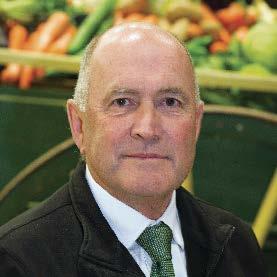
This is fantastic and wow what a change in government direction within that statement for such a critical part of being able to farm and grow, including the confidence to invest. To me it seems the policy supporting water storage has really struggled since the Crown devolved irrigation schemes to industry in the late 1980s, and more recently when Crown irrigation investments reduced. And while this was happening freshwater reforms were introduced, giving the strong signal that storage and irrigation were non-essential for New Zealand, and unfortunately even more so they gave the impression that medium and large-scale water storage was detrimental…!
This all resulted is multiple government agencies, including the Ministry for the Environment, taking a greater role in policy setting, which historically had been driven more by the Ministry of Agriculture & Forestry which became the Ministry for Primary Industries. This in turn then led to regional councils being uncertain about the national policy direction, and as a result very conservative with their interpretations of what they need to be doing.
With multiple government agencies working with a lack of clear government strategy, there has been a lack of coordination and vision, leading to little development of sizeable capture and storage schemes for productive use, for the country’s resilience to climate change, and for potential land use change to better economic and environmentally friendly options, such as for horticulture.
A frustrating situation of the left hand not knowing what the right was doing, and hence the Waimea Dam taking over 15 years to get resource consent, and other dams like Ruataniwha being shelved, and this proposal would have died apart from a small very committed group continuing the fight.
Freshwater accounts for only three percent of the water on the planet, and two-thirds of that is inaccessible either frozen in glaciers or hidden under the earth’s surface, so we only have access to around one percent.
In most regions of the world, over 70 percent of freshwater is used for agriculture. And by 2050, feeding a planet of nine billion people will require an estimated 50 percent increase in agricultural production and at least a 15 percent increase in water used for this production.
Many regions and countries have historically had to live with water scarcity, such as Africa and the Middle East, but now surprisingly, new countries have been added to the list including the United States, Spain and Italy, along with others which are all really struggling with insufficient water for agriculture. Science tells us that due to the impact of climate change we will have more prolonged drought periods, along with more intense rainfall events globally.
Compared to others in the world, New Zealand as a country is blessed with freshwater. It has been and still can be one of our most significant competitive advantages, but due to the lack of government leadership and support, since the 1980s we have dropped the ball big time and not realised the huge opportunities we have in front of our noses.
Our freshwater arrives in rain events where nearly all of it runs out into the sea or it evaporates – a lost opportunity. Just over five percent of our farmland and orchards, or just under one million hectares of land, is irrigated and of this the majority is in pastoral use. Canterbury stands out with 60 percent of its farm area irrigated, just over half of the New Zealand total. Not surprisingly, the regions with the least irrigation are on the West Coast where plentiful and regular rainfall has historically occurred, while the most highly irrigated regions are on the East Coast, such as Hawke’s Bay and Wairarapa, along with Canterbury.
The current poor state of water storage has left the country vulnerable to droughts and floods, and equally importantly has led to significant missed opportunities for investment in diversification of land use, which includes growth in horticulture to realise greater value of land use with a lower environmental footprint. I often compare Kerikeri with Kaikohe, one had an irrigation scheme built in the 1980s and has prospered, the other didn’t, and has really struggled socially and economically; but the good news thankfully is that Te Tai Tokerau is developing water storage for that area now.
So what needs to be done? – Lots, and this government is signalling the right things; and getting the policy settings right for water storage is one of Horticulture New Zealand’s priority areas of focus.
Water storage can be small, medium and large. While there is a place for all, the reality is only large-scale water storage schemes provide for the really significant economic benefits across a region and its communities, so the government getting serious about supporting large water schemes is a good start.
Consenting for big infrastructure schemes absolutely needs central government direction and assistance, or they are likely to get kicked around for an eternity and the life force sucked out of the proponents. The government’s fast-track infrastructure consenting bill is therefore a very welcome development.
Done right, water storage schemes have a positive environmental effect as they can provide water to the river when flows are low, and also capture water to restrict the impacts of flood events. The Opuha Dam in South Canterbury is a great example of this, as will the Waimea Dam be as well.
The proponents of large-scale water schemes cannot devolve their responsibilities for how they take the community, including Māori, with them as they develop their proposals, and will need to work to achieve support. At times they will need to work in partnerships so that they come up with a proposal that has the critical local community and public backing.
HortNZ is proactively involved in influencing government and regional policy to allow for sensible water storage schemes, and working with others such as Irrigation NZ to see this happen. Water storage is one of our three key priorities, so I hope this month’s magazine will result in a robust conversation as to the need and benefits.
If we can get water storage working right, we also won’t have to have such a stoush with water allocation, which when we look at all the competing parties involved can only end up ugly! To me the only solution for us as a country is water storage, storage, storage, and then even more storage!
Kia kaha.With specialist varieties available including the pioneering Rockit™ tree, you could get trees in the ground this winter
Specialist apple varieties available now:

Horticulture New Zealand has now finished its grower meetings across the country and we’ve had some great discussions about a range of issues affecting the sector.
Nadine Tunley : HortNZ chief executive
At these meetings we have been outlining HortNZ’s three policy priorities to support growers: water allocation and storage; climate change and adaptation; food security and supply.
Water allocation and storage has certainly been a hot topic of conversation for growers.
Growers are dealing with the implications of the El Niño weather pattern now prevailing over New Zealand, which means drier conditions for many regions.

This is why ensuring water resilience through availability and storage is a key priority in the Aotearoa Horticulture Action Plan (AHAP) and why we need policies to support the expansion of, and investment in, water storage.
This focus area in AHAP calls for strategic, evidence-based co-investment in regional water storage for climate change adaptation.
We know horticulture is a very efficient user of water but needs a higher degree of reliability than other land uses.
Unfortunately, when a first-in-first-served approach is used to allocate the volume of water allowed to be taken from rivers, and an ecosystem health approach is used to set the minimum flow, horticulture gets caught with the most significant impacts due to the importance of water reliability for fruit and vegetable quality.
In our discussions with the new government, we have been clear that investment in land and water is critical if we are to maintain a thriving horticulture sector.
Acting Editor:
John Gauldie
Email: editor@hortnz.co.nz
Advertising Manager:
Jackie Enright
Ph: 04 494 9986
Mobile: 0274 489 913
Email: jackie.enright@hortnz.co.nz
Design:
Scenario.co.nz
Ph: 04 385 9766
Email: joy@scenario.co.nz
Subscriptions:
Email: info@hortnz.co.nz
This publication uses vegetable based inks and environmentally responsible paper produced from Forest Stewardship Council® (FSC®) certified, Mixed Source pulp from Responsible Sources.
Paper produced using Elemental Chlorine Free (ECF) and manufactured under the strict ISO14001 Environmental Management System.
The wrapper we use is 100% recyclable, it is LDPE 4 (Low Density Polyethylene) Soft Plastic and meets the required standards. For further information refer to: https://www.recycling.kiwi.nz/our-story
HortNZ’s three policy priorities to support growers
Climate change and adaptation
Water allocation and storage
Food security and supply
We cannot grow without the use of New Zealand’s highly productive land. We cannot grow without access to water.
Current policy settings and attitudes – particularly in the areas of land and water use – do not support horticulture’s growth so it has been encouraging to see the new government’s commitment to exploring water storage solutions.
In addition to prioritising water allocation and developing policy settings that support the expansion of and investment in water storage, we also need to ensure that water consent timeframes give growers the certainty to invest and increase production, while improving environmental outcomes.
We cannot grow without the use of New Zealand’s highly productive land. We cannot grow without access to water
That’s why we will be continuing to push the case for growers with government in the freshwater settings space. Over the past few weeks, I have heard the message loud and clear.
Growers want reliable access to water and discharges and policy settings and investment that enable water storage so horticulture can expand in a way that supports freshwater health.
In May and June, growers will get the chance to have their say on the future of HortNZ when voting opens in our referendum.
Without grower support in this levy referendum, HortNZ will be wound up so it’s really important growers engage and have their say on what you want from your levy organisation.
Your support for HortNZ enables us to help you to make more informed decisions for your business, provides you with certainty to invest, gives you tools, resources and services to lift your productivity and profitability, and ensures your voice is heard at all levels.
We advocate on your behalf for sound and sensible policy settings such as in the freshwater space that allow you to get on with business and thrive.
Look out for more information on the referendum which will be coming to all growers soon.
Your levy working for you

It is critical that regulators can recognise industry assurance programmes to deliver freshwater objectives. Horticulture New Zealand successfully advocated for a pathway in law to enable recognition of GAP (Good Agricultural Practice) to audit and certify freshwater farm plans. The detailed pathway is now being designed. Meanwhile, growers continue to demonstrate credible environmental practice using GAP, across more than half of New Zealand’s horticultural land.
Freshwater farm plan requirements are embedded in law (Part 9A of the Resource Management Act). The law is enacted through the Resource Management (Freshwater Farm Plans) Regulations 2023. These regulations have already been turned on in some regions of New Zealand. The new government has signalled the need for these regulations to be more workable and effective. The process for this has not been mapped out yet.
Horticulture is well placed through the GAP schemes to respond to new and changing market and regulatory requirements. GLOBALG.A.P. and NZGAP have been providing assurance that horticultural businesses are producing safe and sustainable produce for 25 years. Growers choose and trust GAP because it is an efficient and effective way to meet food safety, environmental and social practice standards. Stakeholders trust GAP certification because of the integrity and accountability of the system.
GAP standards are integrated and benchmarked against external requirements. Instead of growers interacting with each market and regulator separately, growers choose GAP’s integrated farm planning and assurance framework to demonstrate they meet all requirements applicable to their business, whether they supply the domestic market or export overseas.
GAP standards are risk-based and outcomes-focused. Schemes can remain agile and adaptable as requirements change. Standards are regularly updated to offer highquality and fit-for-purpose farm assurance solutions.
Growers continue to demonstrate credible environmental practice using GAP, across more than half of New Zealand’s horticultural land
It is critical that markets and regulators recognise the importance of GAP schemes and their ability to deliver outcomes effectively and efficiently. Markets and regulators need a pathway to assess and recognise schemes as equivalent to their requirements.
as of March 2024

7,600
Source: 2023 NZGAP Activity report (nzgap.co.nz)
Since the whole GAP system delivers an integrated solution for growers, it is important that the whole system is recognised, not just some parts. In other words, it’s not just about what a grower does on their operation, but also about the audit and certification process, administration and reporting, and the overall operation of the scheme that ensures the integrity behind the standard is upheld.
It is critical that markets and regulators recognise the importance of GAP schemes and their ability to deliver outcomes effectively and efficiently
HortNZ has advocated very strongly for a process to recognise industry GAP schemes. Our advocacy resulted in Ministerial intervention. Now, there is a pathway to recognise industry schemes to audit and certify freshwater farm plans in the Resource Management Act (RMA) through an amendment passed in 2023.
• 170 growing businesses are registered with the EMS add-on and are developing their freshwater farm plans. These business cover approximately 46,000 hectares of land (83 percent of total NZGAP certified area).
• 23 businesses are NZGAP EMS certified, equating to approximately 17,250 hectares, or 37 percent of total land area in the EMS.
• Fruit and vegetables are growing in New Zealand on a total of approximately 80,000 hectares
Over half of this area is captured in the EMS add-on.
Some growers have farm plans through other pathways, for example irrigation schemes or other programmes like Zespri for kiwifruit, that are not captured in these figures.
“This is a significant step in the right direction,” says Michelle Sands, HortNZ general manager strategy and policy.
The exact process for recognition is not yet clear. The horticulture industry is participating in a stakeholder group supporting the Ministry for the Environment’s design of the Ministerial Standard. This standard will detail how GAP schemes are assessed and recognised. If designed appropriately, this pathway could allow recognised schemes to deliver environmental requirements that may come into effect in future. This means growers can continue to use GAP’s integrated compliance solutions to meet future environmental regulation.
Horticulture is leading the way. Despite the uncertainty around this pathway and freshwater requirements in general, growers have continued to adopt farm plans and environmental practices. Many businesses have signed up for NZGAP’s Environment Management System (EMS) add-on for farm environment plans, and now freshwater farm plans. Growers and industry are committed to protecting the environments that we grow in.

HortNZ is proud of our industry and growers’ efforts to demonstrate credible environmental practice.
This collective progress provides critical evidence for HortNZ’s advocacy on behalf of growers in national and regional freshwater policy. Growers need continued access to freshwater, both for water takes and to discharge contaminants. To achieve this, we need appropriate policy settings underpinned by strong evidence and science. Industry led research and implementation is critical to show how the effects of growing on freshwater can be adequately managed through GAP and freshwater farm plans.
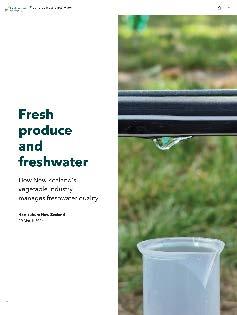
Since the whole GAP system delivers an integrated solution for growers, it is important that the whole system is recognised, not just some parts.
The journey of environmental improvement is more than just audited farm practices. It is rooted in research and industry codes of practice and a collective effort to identify and solve common environmental challenges.
HortNZ is supporting growers to develop freshwater farm plans through programmes like Growing Change. The project is in partnership with the Ministry for the Environment, funded through the Essential Freshwater Fund. Growers are supported with one-on-one professional


advice to develop a freshwater farm plan, and have access to technical workshops on topics like nutrient, soil and irrigation management. Growing Change is also designing a micro-credential on managing freshwater risks from horticultural production based on industry codes of practice and guidance. The micro-credential will support consistent application of practices and tools by growers in their freshwater farm plans.
To find out if support is available in your catchment, visit the HortNZ website; www.hortnz.co.nz/ compliance/farm-planning/freshwater-farm-plans
See how fresh vegetable growers manage freshwater risks on the HortNZ storymap: Fresh produce and freshwater. Visit www.hortnz.co.nz or use the QR codeNZGAP is celebrating 25 years since its first certification. Growers use GAP industry assurance schemes – GLOBALG.A.P. and NZGAP –to meet market and regulatory requirements.
Some problems can be solved on the back of an envelope or a restaurant serviette, but 35 plus years ago, the conundrum facing Russell Jordan needed something much bigger. As big in fact as a sheet of gib board.
“Late one night I was trying to work out an auditing process for an NZGAP approved supplier programme,” says Russell, a grower who was one of the key drivers behind today’s NZGAP (New Zealand Good Agricultural Practice) scheme and the first vegetable grower to be awarded Horticulture New Zealand’s Bledisloe Cup.
Elaine Fisher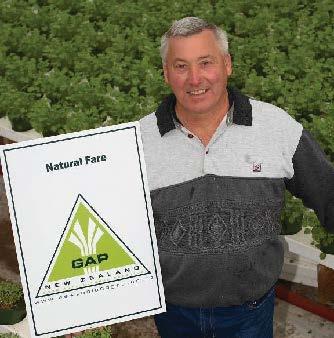
digger destroyed it. It never occurred to me to photograph or keep it.” And so, a piece of NZGAP history was lost.
The story, however, illustrates the commitment Russell and many other growers and industry leaders had to the formation of a quality assurance programme devised by the industry, for the industry, which would provide assurance for consumers of the safe and sustainable production of fruit and vegetables in New Zealand.
“Jan and I were partway through renovating our house and in the hallway was a sheet of gib board ready to be installed, and a felt tip pen.”
Seizing the opportunity, Russell spent the night designing the basis of an audit programme on the board, including the idea of randomised audits and how frequently growers were likely to be audited.
“Years later when the house was demolished, that gib board popped off the wall almost intact. I stood and looked at it for some time, remembering that night, before the
Growers recognised that consumers were increasingly concerned about the origin and safety of their food and that they expected responsible and sustainable farming practices as well as the safety of workers.
Today NZGAP, which grew out of those early aspirations among growers in the mid-1980s, certifies that producers can demonstrate their commitment and ability to meet these expectations. NZGAP certifies New Zealand grown fruit and vegetables. Only certified growers can use the NZGAP logo.
This year NZGAP is celebrating 25 years of the first NZGAP certification outside of the pilots and development of the NZGAP programme.
There will be celebrations in Wellington with a cocktail event in April with retailers, wholesalers, regulators, product groups, district associations, select growers, HortNZ, excommittee members and NZGAP managers invited.
The highly professional, internationally recognised NZGAP of today has come a long way from its beginnings. The quality assurance scheme’s initial focus was on grower and worker safety, Russell says.
“Bruce Woolley was chairman of VegFed when I attended one of my first meetings. The discussion was around the sad event of a grower killed at work and the need to get the whole of the vegetable industry on the same page, with some form of common goal around safety and to have a look at what growers’ legal responsibilities were. “Initially it was seat of the pants stuff because we had no examples on or offshore to follow. We also wanted some formal means of identification for growers complying with the rules.”
Russell became chairman of the Fresh Vegetable Sector Approved Supplier Programme and went on to work closely with the late Ron Gall, who joined VegFed as an executive officer around 1984–5. “I have three brothers and during the years we worked together Ron became my fourth brother. I spent a lot of time with Ron on a number of projects for a lot of years.”
Growers recognised that consumers were increasingly concerned about the origin and safety of their food



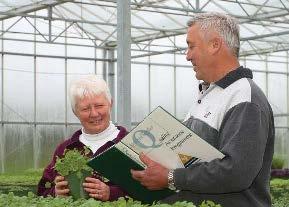

Growers knew the government had plans to bring fresh produce into a food safety scheme and that if the industry didn’t devise its own quality assurance programme, a scheme would be imposed upon it. “Sandra Baldwin [from the predecessor of AsureQuality] and I spent a lot of time trying to nut something out and came up with an approved supplier programme around the end of the 1980s, and not long after that EurepGAP (now known as GLOBALG.A.P) turned up.
“What we conjured up matched much of what was in EurepGAP but they had a whole lot more money than us.
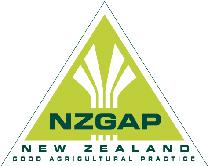

“We got a grant from the Agricultural and Marketing Research and Development Trust (AGMARDT) to fund the original together.”
Some, especially smaller growers, were concerned “I even received death threats. But a remarkable number of gratifying.”
Russell, a relatively small grower himself, was conscious that the scheme should be affordable and fair to growers no matter their scale. “That was one of the reasons for the randomised audits.”
It was around that time that Peter Ensor became involved in the Fresh Produce Approved Supplier Programme which evolved into NZGAP.
“The horticultural industry owes Peter a debt of gratitude. Peter talked the same language as those working on EurepGAP and helped us make necessary changes to NZGAP.


NZGAP is celebrating 25 years since the first certification under the NZGAP quality assurance scheme
“I could see that our scheme should also include food safety, but I hit a brick wall as people were concerned doing so would be getting away from good agricultural practices.” Eventually Russell’s argument prevailed, and food safety became part of the programme.
Russell attended an AUSVEG meeting in Australia and heard Standards New Zealand were holding a two-hour meeting in Wellington.
“I got hold of Ron and suggested he should go along. A week or so later I was in Wellington and asked Ron how he got on. He tossed a couple of books across his desk and said; “didn’t understand a word they said”. The books were the ISO 9000 auditing process, from then on wherever I went those books went too.
“ISO 9001 has seven audit groups which aligned with how we wanted to audit NZGAP and formed the basis of the auditing system we have today. The seven audit groups were never meant to be set in stone but to be flexible and to evolve with the times.”
ISO 9000 is a set of quality management systems standards by the International Organization for Standardization that helps organisations ensure they meet customer and other stakeholder needs within statutory and regulatory requirements related to a product or service.
Initially NZGAP involved only vegetable growers until the summerfruit industry came on board. The turning point to almost universal involvement by both fruit and vegetable growers came, Russell says, when two supermarket chains and two marketers, T&G and MG would not take produce from anyone not involved in the scheme.
Russell also had a vision for a symbol or logo which would identify all quality assured product sold domestically or exported from New Zealand. Today that symbol is the internationally and nationally recognised NZGAP green triangle.
Russell looks back with satisfaction at what the fresh fruit and vegetable industries achieved in establishing a professional quality assurance scheme and acknowledges that “too many people to name” played roles in its formation.
“So many were generous with their time, knowledge and advice and we were also lucky that Jim Sutton, in my opinion one of the best Ministers of Agriculture we have had, was the minister at the time we changed the name to NZGAP as he helped facilitate that.”
NZGAP has evolved and will continue to evolve as the industry and markets change. “It has the flexibility to include new requirements to be audited such as water quality and irrigation without the need to create a new system.”
Russell has retired from active involvement in industry affairs, although he and Jan continue to operate their Taranaki business Natural Fare which grows potted hydroponic culinary herbs for supermarkets and wholesalers.
“I still take an interest in what’s happening with NZGAP and mostly I’m happy, but some things annoy me a bit –that’s probably because after 40 years in the industry I’m a grumpy old grower. On balance it’s a great scheme and I’m proud to have been part of its inception.”
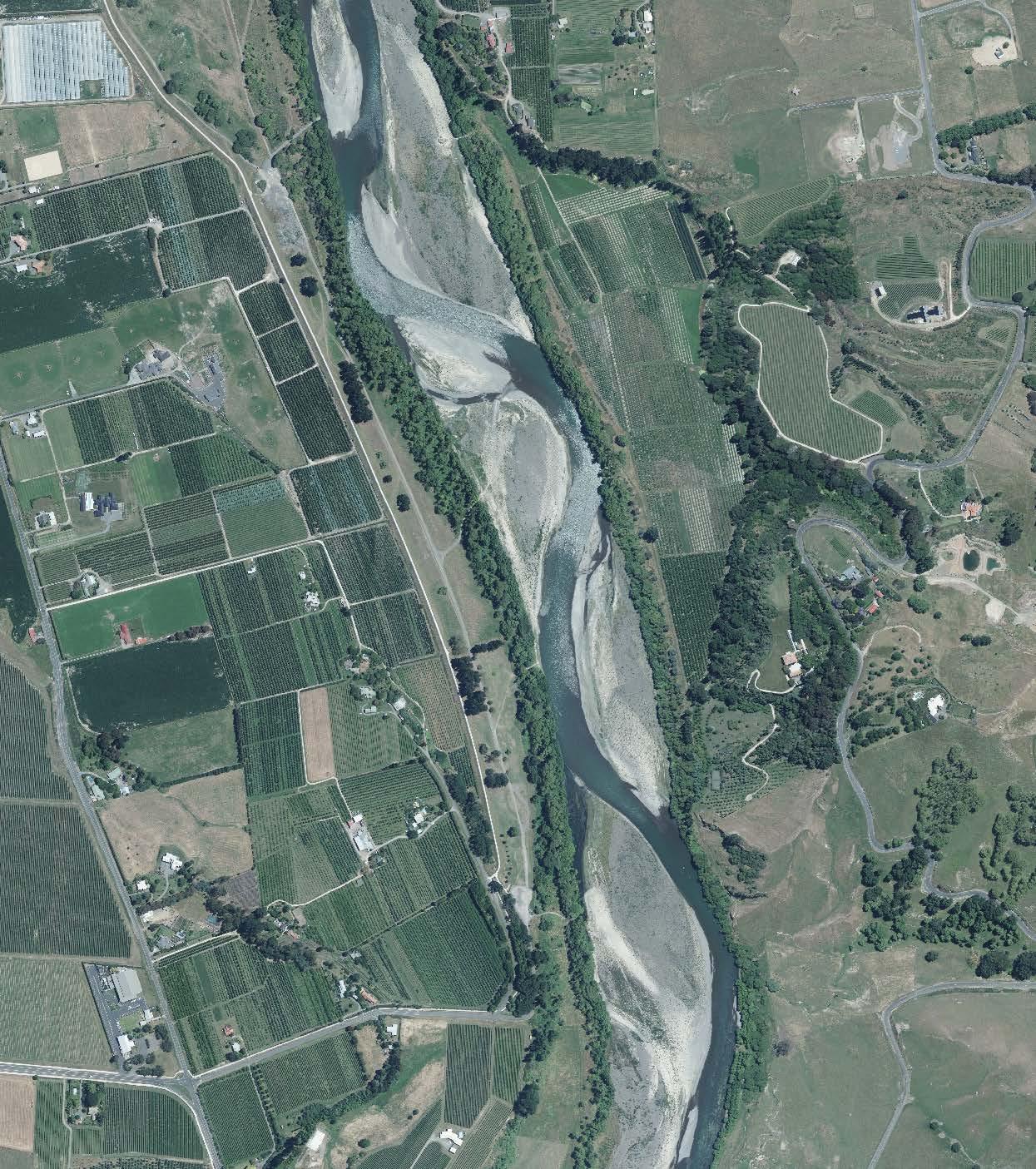 The Tukituki river in Hawke’s Bay
Photo from Land Information New Zealand Data Service
The Tukituki river in Hawke’s Bay
Photo from Land Information New Zealand Data Service
Despite the summer not delivering to Hawke’s Bay the severe drought that was initially predicted, water allocation is still a hot topic for many growers in the region.
This is because nearly 800 expired water permits are currently being considered by the Hawke’s Bay Regional Council. Just before Christmas the regional council advised applicants the volume of water they are likely to be reallocated, and many growers are potentially looking at reductions of their consented paper allocation.
The council’s aim with the reductions is to align consented paper allocation more closely with the volume of water growers actually or reasonably need to undertake their activity. In some cases, quite substantial reductions have been signalled by the council (i.e. reductions of up to 70 or 80 percent). This process has resulted in many asking the question why is our allocation being cut? In this article I will endeavour to explain the planning process that has got us here, what are the possible pathways forward, and what growers could or should be doing in light of this shift in approach to water allocation.
New Zealand’s approach to managing its freshwater resources arguably began to change in 2011 with the introduction of the first National Policy Statement for Freshwater Management (NPSFM). This was the first central government guidance issued under the Resource Management Act about how the country’s freshwater should be managed, and it was intended to drive national consistency in freshwater planning and decision making.
It had four objectives relating to water quantity, which were to: safeguard the life-supporting capacity, ecosystem processes and indigenous species of freshwater; avoid future over-allocation and to phase out over-allocation;
improve efficient use of water; and
protect the significant values of wetlands.
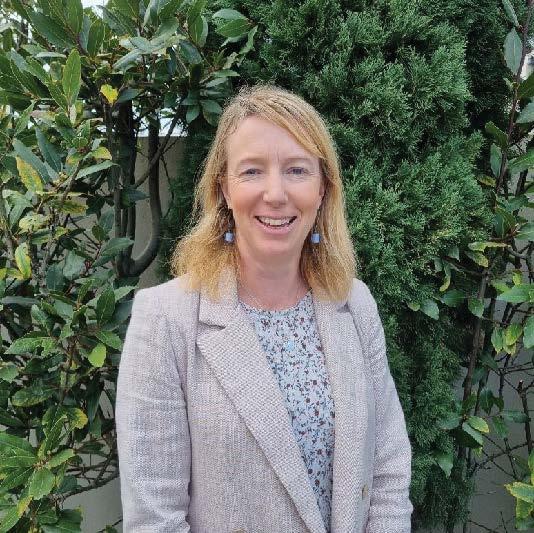
Dr Charlotte Drury, Consultant planner for HortNZ. Opposite: There is increasing hope of progress on water storage in the Tukituki Catchment
The NPSFM was updated in 2014, and again in 2020 (and has also been amended a couple of times), and it is again under review by the newly elected National government. As it has evolved over time, the NPSFM has put increasing emphasis on the importance of maintaining water in the environment, for the environment’s sake, and less emphasis on taking a phased approach to achieve that outcome. The 2020 version has a single objective, which is: “to ensure that natural and physical resources are managed in a way that prioritises:
a) first, the health and well-being of water bodies and freshwater ecosystems,
b) second, the health needs of people (such as drinking water), and
c) third, the ability of people and communities to provide for their social, economic, and cultural well-being, now and in the future”.

the plan development group grappled with was water allocation. Science was presented to the group that showed that the groundwater resource under the Heretaunga Plains was declining, and therefore the current level of water allocated from it was not sustainable. This means (from a planning perspective) that it was over-allocated, and therefore somehow the level of water allocated from it needed to be reduced and new allocations avoided. While many in the community are questioning this science (and are entitled to do so), in terms of a planning process, no party involved in the TANK Plan Change process has challenged it, therefore that is the information that must be used on which to base decisions. There are a range of methods that can be used to reduce allocation. Some of these include pro rata reductions, where all water users are reduced by a common amount, say 15 percent. Targeted reductions are another option, where perhaps bigger water users lose more than smaller water users who arguably have less flexibility. In the TANK Plan Change the allocation mechanism chosen was an ‘actual and reasonable’ use test. The actual use was based on historic water meter data, and the reasonable use component was based on a crop water demand calculation (in this case IRRICALC, but again, there are a number of different crop water calculators used throughout New Zealand – APSIM and SPASMO being two others that have been used at times in Hawke’s Bay). The concept behind the actual and reasonable test is attempting to cap water abstraction at a volume that relates to a baseline period (May 2010 to May 2020). This approach is designed to avoid further over-allocation, by not consenting increased abstractions compared with the water that actually or reasonably was needed to support the activities that irrigators were undertaking during the baseline period.
All allocation mechanisms have pros and cons. It remains to be seen what those are with the actual and reasonable use test. At present the Hawke’s Bay Regional Council is taking a very narrow interpretation of it, essentially only looking at actual use, and putting aside the volume that could reasonably be used to produce a particular crop. What makes the potential impact of this approach difficult in Hawke’s Bay is that there is currently no means of accessing harvested and stored water to reduce the risk of capping groundwater allocation.
The NPSFM required regional councils to set objectives and limits for all freshwater bodies in their region, and avoid over-allocation (in terms of both water quality and quantity). In the Hawke’s Bay region, the first cab off the rank was the Tukituki Catchment, with the planning provisions relating to that catchment becoming operative in 2015. The TANK (Tūtaekurī, Ahuriri, Ngaruroro and Karamū Catchments) were the next to be tackled by the regional council, and a collaborative group was formed to start developing a plan change in 2012. One of the most difficult topics that
The water storage conversation has had new life breathed into it by the new government. There is increasing hope of progress on water storage in the Tukituki Catchment, however large-scale storage serving the Heretaunga Plains is years from being realised. It is generally agreed that storing water is a good concept, however views about the mechanics of how and where that is done, and by whom, are far more divergent and would need time to navigate. In the meantime, how do growers not just survive, but ideally thrive?
The TANK (Tūtaekurī, Ahuriri, Ngaruroro and Karamū) catchments include the Ngaruroro River, photographed here between Twyford and Korokipo in 2022. Photo from Land Information New Zealand Data ServiceAs the planning framework continues to evolve in this space, it is challenging to give clear advice about what growers should be doing. However, irrespective of the exact policy settings moving forward, it will be important for all growers to: understand the water demands of their crops and growing systems,
understand the efficiency gains that can be achieved with improved irrigation technology, and keep high quality water use records.
A good understanding water use data is key to improving growers’ management of risk associated with water allocation settings. Some growers look at their water meter data regularly, others do not even know how to access it. You need to get familiar with it – find out what works for you in terms of the way you can understand it best. Many regional councils will have staff that can assist you with this. You need to understand your water use so that you can pick up any anomalies, and intimately understand your water use profile. This will only stand you in good stead in future
collectively may be clawed back, which is an outcome that penalises the most efficient water users. Global consents offer a real opportunity to optimise efficiency, but these management frameworks do challenge regional councils and existing static planning instruments. They also require a shift in thinking for growers – moving from an individual water permit to being part of a group that collectively manages the water resource.
The water storage conversation has had new life breathed into it by the new government
Water allocation will continue to be a hotly debated topic for some years to come. Horticulture New Zealand is advocating for water allocation frameworks that are designed in a way that rewards water use efficiency and are phased in at a rate that enables growers to reduce reliance on over-allocated water sources as harvested and stored


While researching for my article on irrigation management on page 55, I found AC Yule’s 1958 Honours thesis, “An Historical Geography of a Hawke’s Bay Region”. Yule focusses on impacts of flooding, drainage need and potential for irrigation for the 1840 to 1940 period, something still relevant to the Hawke’s Bay (and greater New Zealand) situation today.
Yule’s research described precolonial Hawke’s Bay rivers in summer as being “slow flowing and silty” with the Heretaunga Plains being largely swampland, valueless without drainage expenditure. Cheap and simple artesian wells were identified as available, giving options for relatively easy irrigation (although the quantum of use is not stated).
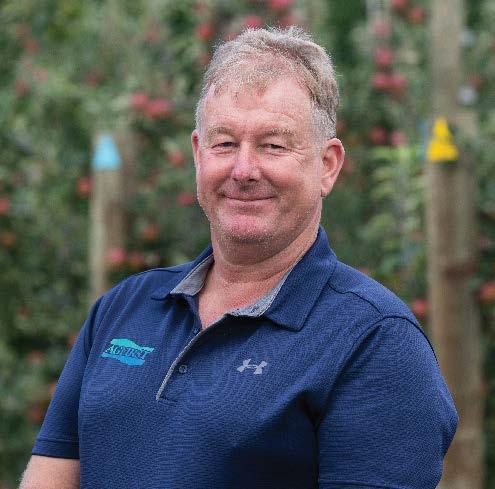 Jonathan Brookes – AgFirst Consultants Hawke’s Bay
Jonathan Brookes – AgFirst Consultants Hawke’s Bay
Yule reports that Heretaunga experienced regular flooding, and the problem of flood control discouraged farmers taking up land adjacent to the three rivers. There was a great flood in 1867, and high stopbanks erected after another disastrous flood in 1897. In 1910, the Hawke’s Bay Rivers Board was formed to investigate river control solutions. Additional severe floods hit in 1917 and again in 1924.
The stopbank systems were again put to the test by the ANZAC Floods of 1938. Yule comments that although stopbank installation helped with flood protection, riverbeds gradually rose with shingle and silt. Some streams became stagnant and marshy, getting choked with willows and swamp grasses.
Flood control, water supply and drainage are problems intimately connected with settlement and landscape changes. Identifying the long-term solutions to these ongoing challenges created “petty jealousies, rivalries and bickering… preventing a realisation of the ideal river control
(Yule, 1958). History is repeating with the current-day scenario of dams for environmental surface water recharge, and the ever-present question, who is going to pay for it?
Records of actual irrigation water use lack accuracy before about 2000, but the accuracy of resource consents, compliance and overall irrigation use is much improved now compared to what happened in the 1980s.
My research also uncovered the 1966 book Fruitful Years by Rex Monigatti, which states that in 1918, New Zealand’s area in orchards totalled more than 50,000 acres, and the total number of registered orchardists was more than 7500. Irrigation from artesian wells was available at this time.
Just because there are no irrigation use records, doesn’t mean it did not happen. I am aware of irrigation of trees, vines and crops being commonplace for more than 35 years, with irrigated area increases somewhat balanced against improved irrigation efficiency during this time.
Growers need water supply confidence based on good science and not wild assumptions. The new assumption by Hawke’s Bay Regional Council that actual historical use is a good proxy for potential need is fundamentally ignoring good science, as the exact growing scenario that creates actual results in a single year is unlikely to be repeated.
Actual and reasonable use are generally not the same thing. Consequently, growers using less water in dry years, through luck or situational management, are being penalised for this. Growers that were less efficient or had a greater need for whatever reason are being given more allocation. This encourages a ‘use it or lose it’ mentality for growers, with highly efficient growers potentially being put at more financial risk into the future.
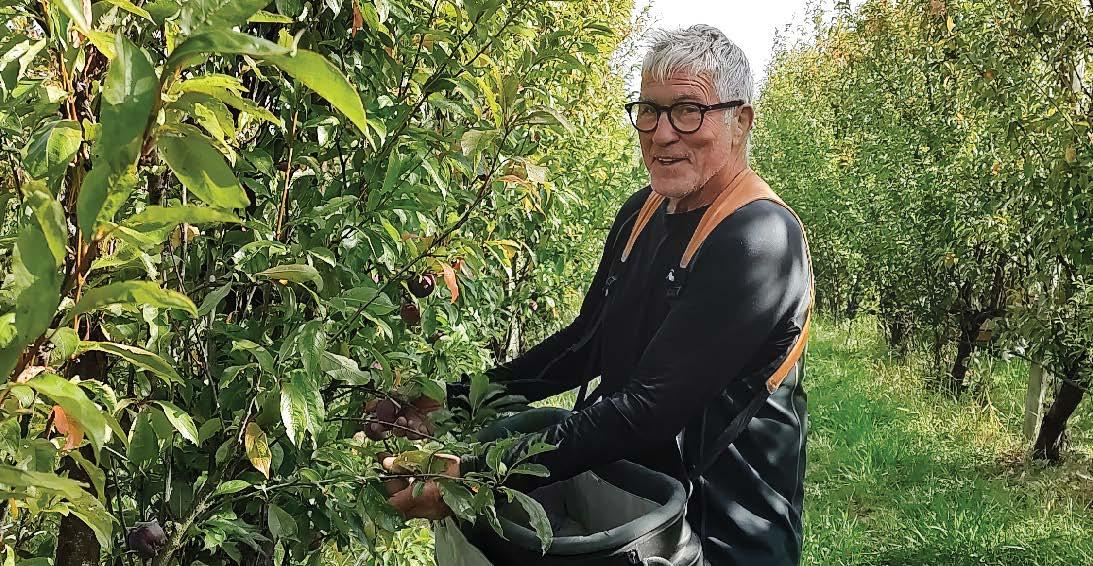
The high-quality Hawke’s Bay stonefruit on supermarket shelves this season belies the long La Niña hangover affecting local growers.
The industry may be going through a period of consolidation, but the future is promising if we make the right decisions, says Summerfruit NZ vice-chair Roger Brownlie.
The Orchardist staff
Bay View’s orchards have traditionally provided the North Island’s early stonefruit harvest. The sunny, mild and sheltered Hawke’s Bay climate makes up for the slightly saline marine soils that run up the coast to the Esk river.
However, last year’s cool spring caused a slow start to the season with summerfruit shoppers left empty handed through December.
“We got underway later than we wanted,” says Roger Brownlie, vice chair of Summerfruit NZ, who owns
The Orchard Hawke’s Bay in Bay View. “I’m happy that the fruit quality was good.”
By the end of March Hawke’s Bay growers had wrapped up the end of season fruit harvests.
This year’s El Niño weather has been generally warm and dry, with some mixed bag summer days in the lead-up to harvest. Overall there were plenty of sunshine hours, and rainfall has been adequate for full irrigation without any restrictions, says Richard Mills, Summerfruit NZ technical advisor.
“Compared to the two previous seasons, quality on supermarket shelves has been consistent. But that doesn’t mean growers have been making a profit. We just haven’t seen the volume of supply out of Hawke’s Bay that we need.”
Richard estimates that the apricot volumes in Hawke’s Bay this year were 70 percent down on a full crop. Cherries also had a tough season. Peaches, nectarines and plums fared a bit better, but still not enough to make a good result for local growers.
Aside from the devastation wrought by Cyclone Gabrielle, the last two seasons of La Niña weather brought less sunshine and more moisture and cooler air, which resulted in smaller fruit and encouraged disease.
“The difficulty in Hawke’s Bay has been getting enough fruit set on trees,” Richard continues. “The trees went into winter dormancy with wet feet held over from the last couple of years and despite a good winter chill, by spring we just didn’t get a full crop set on a lot of trees. The fruit buds went to sleep hungry and woke up grumpy. The trees just didn’t have the energy, they didn’t get good pollination and the spring weather was cool and wet.”
The lack of sunshine hours continued through spring, which combined with areas of poor drainage and blocked drains, hammered this year’s harvest.
Full recovery from Cyclone Gabrielle in Hawke’s Bay will take years. The damage to the stonefruit industry is clear throughout the region. Some former bumper stonefruit blocks are today a handful of surviving trees, or cleared for vegetable crop rotations.
Quality on supermarket shelves has been consistent. But that doesn’t mean growers have been making a profit
Compared to pipfruit, stonefruit trees, particularly apricots, have proven more vulnerable to waterlogging and silt build-up.
Some trees that survived the cyclone have slowly succumbed, leaving patches of poorly performing or dead trees where drainage has been poor or blocked.
However, a warm and dry February and March has helped dry out the soil.
“Most trees should recover heading into winter as long as the settled weather continues,” Richard says. But it might not be so easy for some growers to recover.
“Stonefruit has a relatively high number of mom and pop growers, doing most of the work themselves with small operations. If you lose your trees and your volume is way down, it’s tough to keep going.”
Some stonefruit growers have walked away from leased blocks, consolidating their exposure and finding revenue elsewhere. Others have found property development investors and lifestyle block owners happy to take over their land.
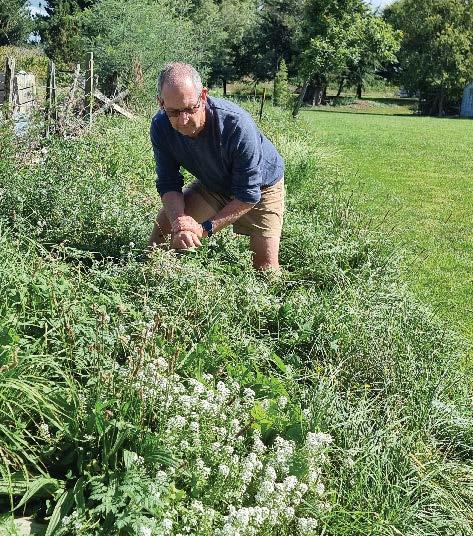
Summerfruit NZ technical advisor Richard Mills at a trial plot of understorey planting near Hastings
Summerfruit NZ is holding a field visit at Georgie and Craig Affleck’s Cromwell orchard on Thursday 11 April. Understorey planting on a demonstration block is part of a Summerfruit NZ – A Lighter Touch project investigating enhanced biodiversity and associated co-benefits such as weed management, improved botrytis disease control through covering bare ground, and improvements to soil health.
For details, contact Richard Mills, Summerfruit NZ technical advisor richard.mills@summerfruitnz.co.nz
Those Hawke’s Bay stonefruit growers determined to replant are struggling to source new trees, with upfront orders requiring several-year waits at major nurseries.
Nevertheless, Roger sees a resolve among many growers to make the most of better growing conditions.
“It’s seasonal, it’s about timing, but that’s what I enjoy about growing summerfruit,” Roger says. “We definitely have a good future in Hawke’s Bay, but the industry needs to come together. We need trees in the right places, the right varieties, and the right timing.”
Combined with a bit of luck with the weather through winter and next spring, there’s every reason to hope for a strong summerfruit supply out of Hawke’s Bay next season.
Just over five percent of New Zealand’s agricultural land is irrigated, meaning the vast majority of pastural land (in particular) is reliant on natural weather patterns and has little resilience to a changing climate.
Vanessa Winning : Irrigation NZ chief executiveThis makes it very difficult for farmers and growers to invest in new horticulture projects, as without water at the right time in the growing cycle, production is at risk. And while the ability to utilise irrigation grew in the early 2000s mainly due to new technology and improved water efficiency, it has been very difficult to get new irrigation storage projects underway in the past nine years.
This is due to poor understanding of what the water will be used for, investment for long term intergenerational assets being difficult to access, and regulatory restrictions regionally and nationally. These impediments have left New Zealand food growers vulnerable to a changing climate and have removed choices for land use.
Just two large water storage projects have come to fruition in the past six years.
With Waimea Dam (see page 32), the pay-off for the region is immediate. Not only are the vegetable and fruit growers ensured they have the water they need at the right time of the growing cycle, they are removing their reliance on ground water, insulating the township from forest fires, and providing reliable drinking water, all while improving the flow of the river.
Te Tai Tokerau water project (see The Orchardist March 2024) is about halfway through to completion. Ultimately the idea is to link the Northland schemes across the area to provide reliable water for what could be a thriving food bowl, and provide a much-needed economic boost and jobs for locals. Water is the enabler.
Over the past 12 months the importance of the water storage issue and its impact on our ability to grow food has started to pick up steam again. During the election and since, we have seen more stories and emphasis on how we do this better, and we are starting to see more enabling legislation to support development. With more certainty we will get more investment and growers trying different crops and developing land for additional uses. The flow on is

From right: Vanessa Winning visiting Te Tai Tokerau water storage construction in Northland with MP for Taranaki-King Country Barbara Kuriger and former Foreign Minister and Chair of Te Tai Tokerau Water Trust Murray McCully
jobs, supporting infrastructure, drinking water and community recreation facilities. Not only can these sites support drying conditions but they also help during floods and weather events. The frustration is that New Zealand gets enough water for all of us to thrive, but we don’t always capture and store it for those days we most need it. If we want to see a doubling in our horticulture economy, we will need to invest in more storage and capture of water and be smarter about the whole of community benefits it can provide.
IrrigationNZ represents irrigation schemes, individual irrigators, irrigator user groups, and the irrigation service industry. www.irrigationnz.co.nz

While the threat of widespread drought across some parts of the country is still very real, recent water restrictions in Central Otago have forced some orchardists to the brink.
The 90-year-old Falls Dam is as good as dry, and the Manuherikia apple harvest this year has been helped by the cooperation of all primary sector water users and some last-minute respite from mother nature.
AIMEE WILSON speaks to local growers and the regional councillors advocating for the serious storage investment that could fulfil the catchment’s potential as a major horticultural production area.
Orchardists growing fruit in Central Otago’s Manuherikia catchment say they may not be in business in 2030 if there is not enough water to keep their trees alive and their fruit cool over the long dry summers.
This season was the first since 1999 that the Falls storage dam near St Bathans was left with just emergency water only from late February, forcing 75 percent restrictions on irrigation scheme users – effectively down to just stock water only.
The apple harvest for those growing in the Manuherikia catchment just scraped through. On day two after the dam level dropped to zero percent, mother nature delivered the goods when it rained for 24 hours. But then there was no substantial rainfall forecast for another month.
Meanwhile, on the other side of the Clutha River in Earnscleugh, orchardists are operating from a hugely abundant scheme straight out of one of the biggest rivers in New Zealand.
It hasn’t always been that way. The situation came about after the Clyde Dam was built and Lake Dunstan was filled in 1992. Horticultural consultant and Manuherikia grower Earnscy Weaver says the Manuherikia catchment was also meant to have water from the Clutha River, but that never eventuated.
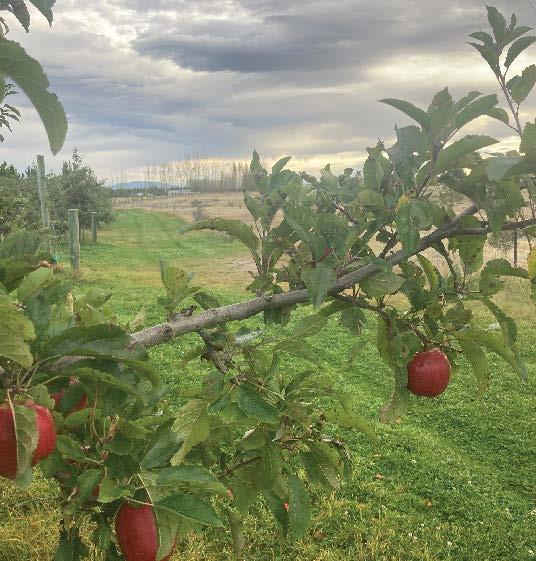
In recent years the number of people relying on the Manuherikia River has increased – the majority being lifestyle block owners.
One of the local growers is Central Organics, whose 100ha apple and cherry orchard near Alexandra is almost last in line geographically in terms of the Manuherikia irrigation supply. On 28+ degree Celsius days the extra water is necessary for hydro cooling.
Owners Chris and Maree Denniston also run the second biggest organic packhouse in the country – a 40-minute drive away in Ettrick, where they pack apples for 13 other orchards including some located in Christchurch and Nelson – as well as their own.
Irrigation water is vital to the success of the orchard and they have learned how to become efficient at storing what they don’t need immediately. But they say any more water restrictions would be a nightmare and effectively spell the end for orcharding.
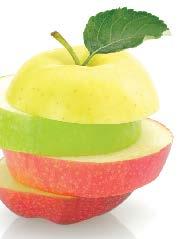
20 million m3
The Falls Dam proposal aims to increase the capacity of the existing dam, which was built in 1935, to 20 million cubic metres, raising the water level approximately six metres.
12,500ha
The new dam could irrigate up to 12,500ha of farm, lifestyle, horticulture and viticulture properties in the Manuherikia Valley.
$100 million
Estimated costs are about $100 million.
Orchardist Murray Bell is a partner of Springvale Apple Growers and his fruit is packed by Central Organics. From January to March this year they have been on constant water restrictions – since the Falls Dam that feeds into the Manuherikia River fell below 50 percent capacity.
In recent years the number of people relying on the Manuherikia River has increased – the majority being lifestyle block owners
But under the proposed Land and Water Regional Plan, those restrictions would have kicked in much earlier –on 5 December last year. In future, without substantially more storage than the Falls Dam can provide, the local horticulture and viticulture industries will struggle to survive
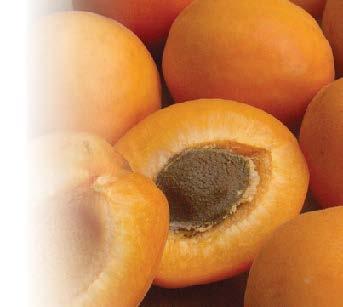



“It will be devastating for the local economy,” Murray says.
Central Otago is an increasingly strong fruit growing area thanks to its hot dry summers and cold winters. The lack of disease makes it even better for the growing of organic produce, he continues.
“But there is no arable land if we don’t have water. Water is like liquid gold,” Murray says.
Without substantially more storage than the Falls Dam can provide, the local horticulture and viticulture industries will struggle
This season’s drought just highlighted how scarce water is in parts of Central Otago. Regional councillors Gary Kelliher and Michael Laws have been advocating for the hundreds of primary industry users that rely on the Manuherikia River. Just a week before water restrictions were put in place, the Otago Regional Council decided to push on with its Land and Water Regional Plan – effectively raising the level of the Manuherikia River threefold by 2040, and seriously affecting water allocations of some 800 landowners within the catchment.
The controversial work has been going on for five years and Michael and Gary – the two Central Otago-based regional councillors – have been strongly against it from the start.
Gary, who is also a farmer in the catchment, believes the degradation of the Manuherikia River that the council was trying to fix is questionable.
He says the council is unjustifiably characterising the river as over-allocated, degraded and over-utilised. He thinks the environment can continue to be protected, “but we need better and more productive land use into the future.”
Also a shareholder of the Manuherikia Irrigation Scheme, he and others gave up their deemed water permits several years ago and now only use scheme water, no longer relying on creeks that run through their properties.
The 90-year-old Falls Dam at the head of the catchment in the Manuherikia is where the overall problem lies
He effectively compromised his position to show others what could be done. “To me it was the right thing to do for the catchment.”
On the Manuherikia Irrigation Scheme, livelihood always comes before livestock and lifestyle. The needs of orchardists and viticulturists are met first, but Gary says many people struggled to run an efficient business when the consistency of water just wasn’t there.
“The area is suited to that land use and we can grow it to an international level quickly. But it’s fragile and the risks are many, and I have to live with that,” Gary says.
He believes nature will always provide, “and Central Otago never lets you down,” but admits this season he’s been worried the rain may never come.
“And orchardists are very reliant on us to keep their trees alive,” he says.
Looking at the bigger picture, the 90-year-old Falls Dam at the head of the catchment in the Manuherikia is where the overall problem lies.
As Gary explained, while it is a safe dam, if you were making a call for the next 100 years it will need to be upgraded. “The catchment knows we don’t have enough storage so we have to build a new one.”
The proposed Falls Dam irrigation project has been on hold for several years. The cost is likely to exceed $100 million. The coalition government has already indicated that it supports better water storage, igniting hopes for a renewed focus on the project.
“The old timers got it right, but they just didn’t build it big enough,” Gary says.
That critical infrastructure needs to be maintained, enhanced and enlarged if at all possible, so the horticulture industry has reliability of water supply that it desperately needs for frost fighting and hydro cooling, he says.
Organic apple growers Chris and Maree Denniston along with Murray Bell on the Springvale orchard near Alexandra
As parts of the country battle drought conditions, HELENA O’NEILL speaks with long-serving horticulturalist Ratahi Cross about water security and how important this is to the growth of Māori participation in high-value horticulture.
Ratahi Cross is a very busy man, whose family has managed orchards for 50 years across three generations in the Bay of Plenty. Ratahi has a background in natural science specialising in native flora and fauna, and also lectures in Māori history for several iwi he belongs to.
He is the chairman of several trust boards throughout the eastern areas of the North Island including Ngāi Tukairangi Trust, the largest Māori kiwifruit grower in New Zealand. The trust operates orchards on the Matapihi Peninsula at Mount Maunganui and in Hawke’s Bay.
The trust has eight kiwifruit and apple orchards around Hawke’s Bay, most of which were flooded last year during Cyclone Gabrielle. Its worst-hit orchard was a 22-hectare kiwifruit orchard in Puketapu, next to the Tūtaekurī River.
Ratahi says water availability and future planning are key to the orchards’ recovery.
“We’re at that stage in Hawke’s Bay because we had Cyclone Gabrielle. We have to look at the way we use water because it’s important to how we recover. Back to basics and a good set of plans is what we should come out of in the recovery of Hawke’s Bay.”
Traditionally iwi have chosen areas with good water sources to settle and farm, a decision which has left Māori with land that is good for growing.
“Iwi here are quite well-placed. In those areas where economic development needs to take place, the balance is quite great. But it will become a problem if we don’t plan, 25, 30, or 50 years out – because what comes with economic development is population growth,” he says.

Investments are being made to improve water storage and security on iwi land and orchards, with an example of this being a kiwifruit and water storage development project in Raukokore and Waihau Bay. The project aims to cultivate more economic development and employment opportunities, with the most recent development being a further eight hectares of land developed in Waihau Bay.
The project began with funding from Te Whānau a Maruhaeremuri Hapū Trust, which included two linked projects, the Raukokore and Waihau Bay community irrigation scheme and the development of a kiwifruit orchard which would be irrigated by the new scheme.
The 30-year partnership with local iwi hopes to make these orchards provide sustainable, permanent employment opportunities
The long-term strategy for the kiwifruit orchard development project is to transform 200ha of low-returning Māori-owned land with high horticultural potential, located across multiple Māori land blocks in Raukokore and Waihau Bay, into kiwifruit orchards. The 30-year partnership with local iwi hopes to make these orchards provide sustainable, permanent employment opportunities and economic growth for the area, with revenue generated from the high-value crops that will be packed at Seeka.
The initial orchard is named Wai o Kaha and includes 40ha of kiwifruit planted across five orchards: Tawaroa, Otaimina, Raekahu, Toopu and Orete. Seeka is investing in the Wai o Kaha project and is also the orchard developer, responsible for planting the vines, running the orchard, and hiring local employees. The development project began in late 2020 with Tawaroa and Orete orchards, followed by Otaimina orchard in 2021 and Raekahu and Toopu orchards in 2022.
Ratahi, who is also a non-executive director on Seeka’s board, says the project is progressing well.
Seeka also provided a share of the funding for the Ngutupiri development, where a further 12ha of land was developed for kiwifruit in Te Kaha, with the plants coming from a local Te Kaha nursery.
He says that iwi are quite responsible with water and planning around it.
“Most water on iwi land at the moment is either by a river or artesian, we don’t have a storage capacity as such. It’s naturally occurring water. What we need to do is measure that capacity, and I don’t think we’re doing that enough. We need to measure that so we know what that finite number will be, and then develop the kind of holding capacity that we need. It’s a lot easier to build a dam now than to try and build it after the event of running out.”
“Water is going to be a real problem, there’s no doubt about it.”
One of the key priorities in Horticulture New Zealand’s Aotearoa Horticulture Action Plan (AHAP) strategy is to ensure water resilience through availability and storage. The outcome sought is strategic, evidence-based co-investment in regional water storage for climate change adaptation.
With climate change and water becoming more precious, balancing environmental, social and economic interests is a major challenge, he says.
Water is probably 60 percent of the argument, people are 30 percent, and ten percent are the plants
Te Mana o te Wai is a concept that refers to the fundamental importance of water and recognises that protecting the health of freshwater protects the health and wellbeing of the wider environment. It protects the mauri (life force) of the wai (water). It encompasses the relationship between water, the wider environment and our communities.
“We need to sit down and be honest with one another about what our needs are. I believe that at the moment, horticulturalists have a better insight into their water conservation and usage compared with any other interest groups. Other parties including communities, environmentalists and agriculture, need to measure what the reality is. I believe that horticulturalists are way ahead.”
Horticulturalists are in tune with the environment and observant of the small things, he says.
The Wai o Kaha project includes 40ha of kiwifruit planted across five orchards
“I know exactly what the needs are for each ten hectares of land that we use.
“One of the beauties of being Māori, and I think New Zealanders as a whole, is that we are very aware of what’s happening around us.”
In the context of the Aotearoa Horticulture Action Plan (AHAP) which includes the key outcome of Māori participation in high-value horticulture tripling by 2035, Ratahi says water has a large role to play.
“Water is probably 60 percent of the argument, people are 30 percent, and ten percent are the plants.”
Ratahi reiterates that careful management of resources, from determining the true need to finding suitable storage solutions, is key to growth across the industry.
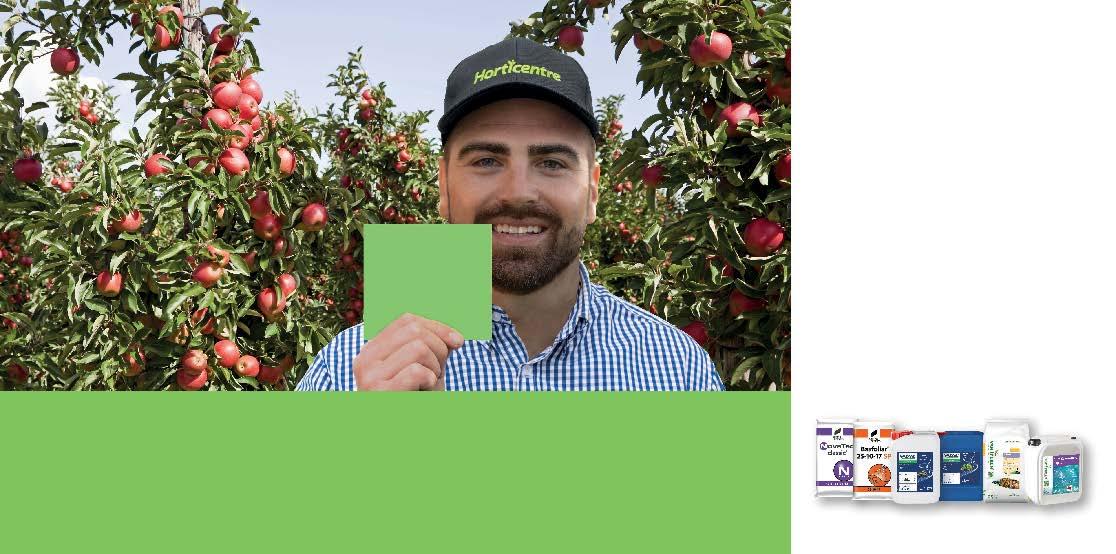

 Tawaroa Otaimina Raekahu
Tawaroa Otaimina Raekahu
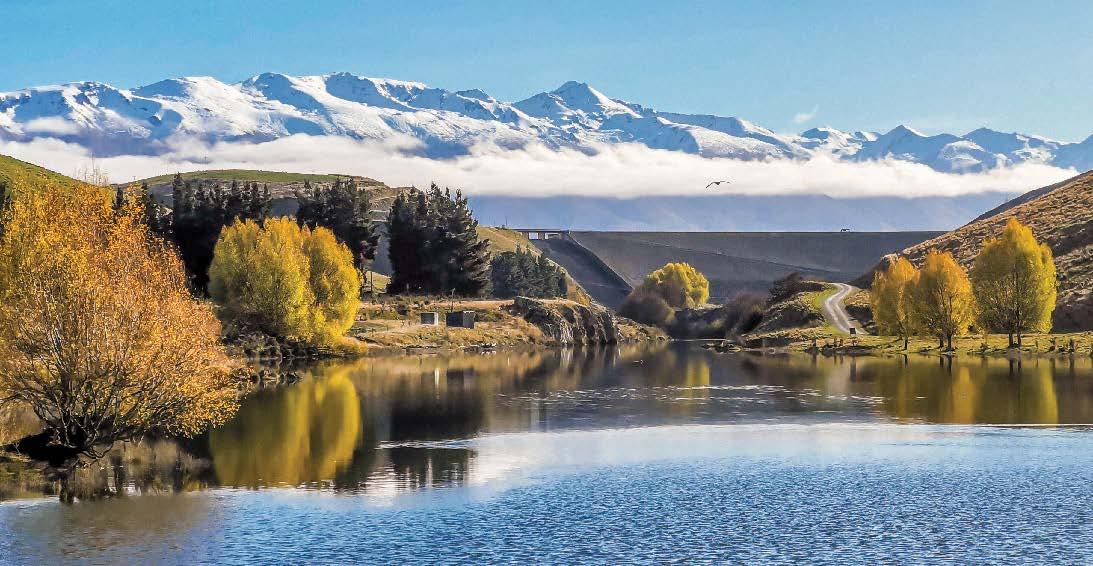
For 25 years the Opuha Irrigation Scheme has brought prosperity to South Canterbury farmers and growers along with supplementing Timaru’s water supply and minimising the effects of flooding.
Tony BennyWhen the proponents of damming north and south branches of the Opuha River, just north of Fairlie, to store water for irrigation went looking for investors, they chose a tough time to do it.
“The mid-1990s were difficult economic times,” says Opuha Irrigation chairman Ryan O’Sullivan. “It was near the end of ten really tough years in farming, both climatically with three years of severe droughts in the 1980s, as well with Rogernomics which really pulled the rug out from under farming.”
The Opuha scheme was the first to be built after a huge shake-up in the way irrigation schemes were constructed and managed in New Zealand. Until the 1980s they were generally built by the Ministry of Works, but that changed
when the National government of the day abandoned the partially constructed Maniototo Irrigation scheme in Central Otago because of a budget blowout.
When Labour came to power in 1984, Finance Minister Roger Douglas not only abolished farming subsidies, he also got the government out of the irrigation business altogether and all the state-owned schemes were sold to the farmers who used the water.
With no central government support forthcoming, the group of enterprising individuals who drove the project had to find another way to pay for it.
“It was a local initiative with local people finding solutions to local problems, so it really was cap in hand to anyone who would listen and there was no central government
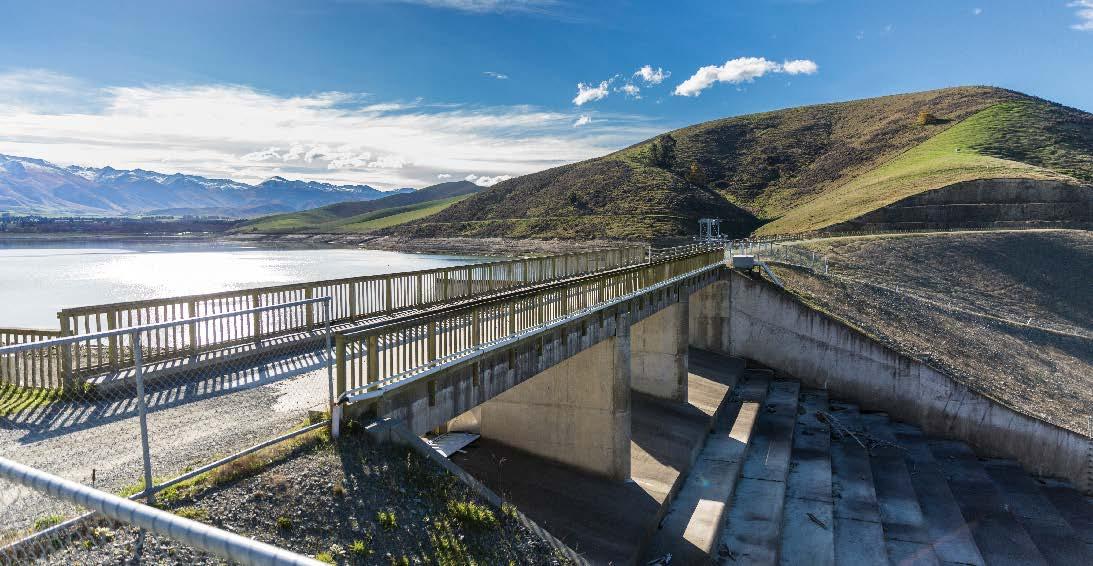
money as such,” says Ryan. “While it was only $34 million, it was a hell of a lot of money back in those days and it was certainly challenging.
“There was funding assistance from local government and the local lines company but it was really farmers, bank finance and one of two underwriters in their private capacity that got the whole thing off the ground.”
The 300-metre wide, 50-metre-high dam holds roughly 73 million litres which is used both to irrigate 16,000ha as well as provide environmental flows for the Opuha River, as well as the Ōpihi River of which the Opuha is a tributary.
“In very broad numbers there will be about one fill per season applied to land for irrigation and another three fills are used to supply environmental flows, so generally it turns over about four times a season.”
“We’ve got 25 years of service now. It was designed for 95 percent reliability and it is achieving that or better.”
Bringing reliable irrigation to the region has been transformative for South Canterbury which previously struggled to match neighbouring Mid Canterbury’s agricultural prosperity because it doesn’t have the same reserves of groundwater that can be accessed by bores. Additionally, the big alpine-fed Canterbury rivers from which other districts draw irrigation water don’t flow in this corner of the province.
Opuha Irrigation has commissioned a number of economic studies over the years, and they show the scheme is an important contributor to the local economy. “Admittedly
300m x 50m
The dam is 300m wide by 50m high
73 million litres of water is held
16,000ha of land is irrigated
those studies are getting pretty historic now, but you’re talking annual benefits accruing of $100 to $200 million annually so that’s a lift of GDP (gross domestic product).
“These irrigation schemes change land use, more intensity, higher cost structures, therefore spending in the community with more jobs, more wages and more rates. The economic impact of that is pretty well documented and it’s extremely beneficial for the local economy.”
A relatively small amount of Opuha’s water is used for horticulture, only four percent, compared with 50 percent for dairy farming, with the remainder going to arable, dairy support and Timaru’s water supply. But Ryan says horticulture is expanding in South Canterbury, especially near the coast.
The Opuha Dam’s 7-megawatt turbine generates power for the local network, on average powering 4000 to 5000 homes
“Apples seem to be getting a strong foothold in South Canterbury. We have a couple of shareholders who are into Honeycrisp and Rockit™ apples and that’s a good alternate land use. Berries and blackcurrants are proven in South Canterbury too.
“With climate change, in another ten or 20 years do we have grapes or kiwifruit in Canterbury? You couldn’t rule it out, and we’ve got the infrastructure there with the port and really good logistics, expertise and engineering.”
The scheme’s not only an important contributor to the local economy, it also played a vital role in moderating the effects of flooding in 2021, holding back much of the flow from the back country thanks to spare capacity behind the dam at the end of the irrigation season.
“The lake level was 12 percent pre-event, and post-event it was 85 percent, so we were able to swallow a lot of water into the reservoir,” says Ryan.
“The Ōpihi River measure at Pleasant Point reached around 800 cumecs, and the flow at the State Highway 1 bridge further downstream was higher again at over 1000 cumecs, with substantial flows backing up the Temuka River system. Had the Opuha Dam not held back the high flows in this catchment, which peaked at 452 cumecs, the lower reaches of the Ōpihi River system would have been higher again with likely substantial more community damages as the result.”
“That was a real recognition, even from ourselves but particularly the wider community, of the benefit the dam brings to flood attenuation.”
When water flows from the dam it turns a 7-megawatt turbine that generates power for the local network. There tends to be a massive swing in the amount generated each year; that depends on the season. “We generate when we release water, and we don’t generate when we’re trying to fill the lake, but on average each year it powers 4000 to 5000 homes. It’s quite a useful offset to our operating expenses.”
Opuha Dam has fulfilled the dreams of the enterprising individuals who pushed hard for its construction, bringing reliable water to farmers as well as benefitting the local economy more widely. Now much of the focus is on earning community support to help ensure the scheme maintains its licence to operate.
We’ve got 25 years of service now. It was designed for 95 percent reliability and it is achieving that or better
“We take our obligation around preserving or enhancing water quality seriously, and we actually have our own freshwater ecologist and environmental team of three, and we’re developing a really good database of water quality monitoring sites.
“We want to be able to demonstrate we’re not having an adverse impact.”
The Opuha Water Ltd board of directors from left: Richard Green, Ryan O’Sullivan, Elena Trout, Paul Burns, Tony Howey, Rebecca Biggs, Brent Schrider and Brendan CairdWhether there’s potential for more irrigation schemes to be built in Canterbury, Ryan’s not sure, especially since two proposals over the past few years, one in South Canterbury and another in North Canterbury, failed to get sufficient farmer support.
“It’s just a matter of finding the water source that’s not already fully committed, and that’s a difficult conversation because one person’s over-allocated is another person’s ‘there’s still heaps of water available’, but we do let a hell of a lot of water go to sea in Canterbury, especially from the big rivers in flood.”
He’s not expecting the state to step back into irrigation like in the old days, but hopes the new government may be more supportive than the last one.
“I think the vehicles are probably consenting pathways, making that as easy and low cost by not having to have armies of lawyers on both sides of the debate fighting it out for two or three years on whether to consent a project or not.
“The economic impact is pretty well documented and it’s extremely beneficial for the local economy and the national economy, so there’s a great argument for central government to get in behind new irrigation.”













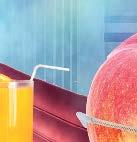


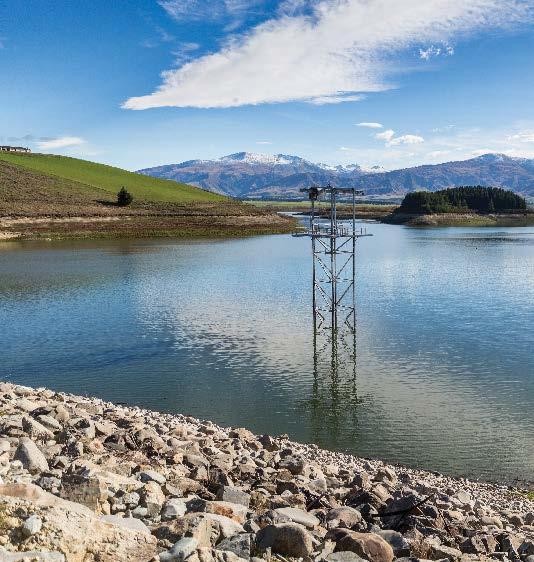




























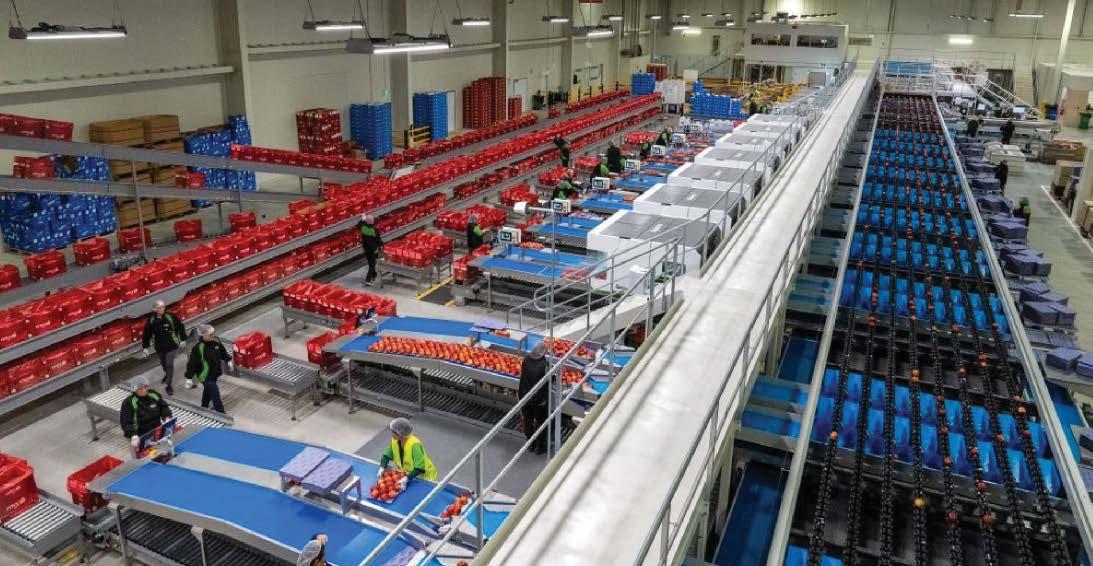
T&G Global’s harvest in Hawke’s Bay is off to a great start thanks to near-perfect apple growing conditions.
The Orchardist staff
Although Cyclone Gabrielle’s impact has resulted in consolidation and will affect production for another two to three years, the company continues to invest in new 2D plantings. But it will be some time before its state-of-theart Whakatu packhouse will be working at full capacity.
T&G Global’s new $85 million Hawke’s Bay packhouse is working through its first full season since it was commissioned in May last year.
The company says the Whakatu facility is one of the largest apple packhouses in the Southern Hemisphere. It will be able to pack more than 125 million kilograms of apples per season once its two-phased construction is complete.
The first-phase 100-metre packing line boasts a capacity of processing 3000 to 4000 apples per minute. When the second line is installed, T&G says it will be able to pack up to 190 bins per hour, with a similar number of people.
Craig Betty, director of operations for T&G, says, “Our Whakatu packhouse helps ensure we have the capacity to handle increasing volumes of fruit and that the quality of our fruit is prioritised by utilising some of the world’s leading AI (artificial intelligence) defect sorting, soft fruit handling, and robotic fruit packers and palletiser technology.”
In early February T&G and its growers began harvesting early season varieties including Poppi™, Royal Gala and Pacific Queen™ in Tairāwhiti Gisborne and Hawke’s Bay, followed by Jazz™ in March.
Across the country this season, T&G expects that it and its growers will collectively pick 4 million tray carton equivalents (TCEs) for domestic and overseas markets.
“In addition to Jazz being readily available in stores across Aotearoa New Zealand for Kiwis to enjoy, in late March our first shipments will depart Hawke’s Bay for Hong Kong,” says Craig. At the time of writing the first Jazz shipments were due to depart Napier Port bound for Asia and will be available in China, Japan, Malaysia, Thailand and Vietnam. This will be followed by the South Island Jazz crop, which is now being harvested.
T&G’s Envy™ apples will begin to be picked from early April. Over the last five years, T&G has redeveloped hundreds of hectares into modern 2D growing systems, with increased plantings of Envy.
were severely damaged, which equated to approximately 13 percent of the company’s planted hectares in Hawke’s Bay. This included its first fully 2D orchard, the 47ha Ebbett Orchard beside the Tūtaekurī River.
“We had to make the difficult decision to terminate the leases of some orchards.”
Many of T&G’s orchards survived the worst of the storm, although it took seven months to clear the silt and debris.
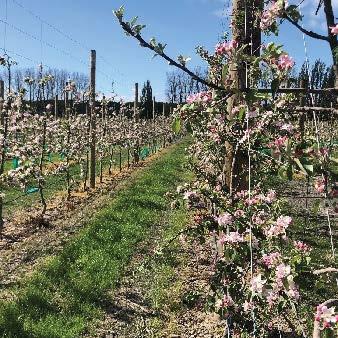
Craig says the maturing of some of the newer recently redeveloped 2D Envy orchards is helping drive volume growth. Envy exports are expected to increase from 2.2 million TCEs to 2.9 million this season, as the first fruit comes off new plantings, and trees continue to mature.
Last year, Cyclone Gabrielle struck Hawke’s Bay just as the harvest was getting underway. Four of T&G’s orchards
“Our team, together with our independent growers, have put in a huge amount of work to clean up and restore orchards. The quality of this season’s crop is testament to their dedication and effort.
“We expect a further 22 percent of our planted hectares in the region will have reduced productive capacity for two to three years given damage to the trees.”
Last year saw the first commercial plantings of Joli™ – which is part of a planned 27ha on Hawke’s Bay orchards over the next three years. A further 100ha will be grown under licence in New Zealand.
Overall, despite the ongoing impact of the cyclone, T&G Global chair Benedikt Mangold says there is much to be encouraged about in the new season, with apple volumes looking strong.
“We have a strong leadership team and workforce who have shown considerable resilience, determination and initiative in a difficult year.”
In our world of twigs and roots pedigree is everything.

As we all know, in the fruit growing industry ultimately everything stems from a twig. We have alliances with some of the world’s best new fruit variety developers and rootstock breeding programmes. These relationships and our continual search for the best cultivars puts us at the forefront of global variety and rootstock development in New Zealand.






Our unique capability across a wide variety of crops and our focus on matching varieties and rootstocks to conditions allows us to offer real, informed advice. Call:
Grant Bryan, 0274 201 003, grant.b@waimea.group
Kate Marshall, 0274 201 033, kate.m@waimea.group


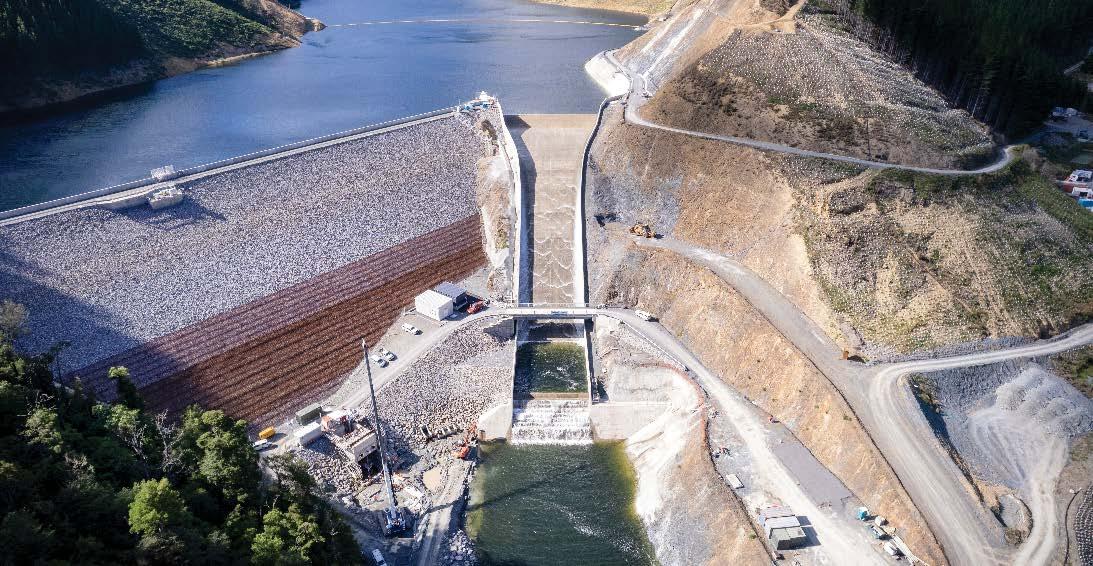
The Waimea Community Dam has been a quarter of a century in the making, but it is finally releasing water into the river to fill the aquifers and provide a reliable source of water for the next 100 years.
Anne HardieIt ended up costing an estimated $198 million and was two years behind schedule, but for growers like Bruno Simpson at Waimea Nurseries, it is a huge relief to get to the finish line and he admits they got through the last two years ‘by the skin of our teeth’.
Behind the 53m high concrete face of the dam is the ability to hold 13 billion litres of water in its reservoir, Te Kurawai o Pūhanga, making it the largest public dam to be constructed in New Zealand since the Clyde Dam in the early 1990s.
It was back then, Bruno explains, that the idea of a dam was first mooted in Tasman as regular droughts took their toll on the productive Waimea Plains and urban communities. Then the 2001 drought hit – the Big Dry as it was named by
NIWA (National Institute of Water & Atmospheric Research) – that was the worst regional drought on record and resulted in the Waimea River drying up in parts of the lower reaches, seawater incursions of some of the town water supply bores as well as irrigation bores and severe water restrictions. The region lost millions of dollarsʼ worth of horticulture produce that year and it revealed an uncertain future for urban water supply as the population increased.
Climate volatility meant reliable water was no longer guaranteed and that brought together farmers, growers, iwi, Department of Conservation, Fish & Game NZ, the wider expanding community, commercial developers, the environmental sector and both local councils to collaborate on a dam project.
Eighteen potential sites were assessed for engineering, environmental and social factors before selecting the Lee Valley site for its ability to capture rain in its headwaters as well as the Lee River at its base feeding into the Waimea waterways and aquifers. To prove the point, in August 2022 a one-in-50-year storm event dropped 187mm of rain in the catchment that resulted in more than 30 million cubic metres of water flowing through the dam site. Enough to fill the reservoir two-and-a-half times in four days.
As dam plans were made, the costs continued to rise though, and ultimately the only way to get it over the line was through larger-scale irrigators digging deep into their pockets to buy surplus shares. Tasman District Council now owns 51 percent of the dam, paying for 21 percent of its urban share through water rates, charges and $5 million from neighbouring Nelson City Council. The other 30 percent of the council’s share is for environmental, economic and community benefits which is funded by targeted rates, Crown Irrigation Investments Limited (CIIL) loans and enterprise income.
Waimea Irrigators Ltd has funded the other 49 percent of the dam costs and it has done that by selling shares to irrigators and rural people, as well as securing loans from CIIL. Century Water is a company formed by a number of the larger irrigators who pulled together $11 million to purchase all the additional shares in the scheme above the 3000 shares purchased by Waimea Irrigators.
When the project was first presented to the public in 2017, it had a price tag of $79.5 million and by its completion that had risen to $198 million. The biggest hurdle for the build and cause of increased costs was the discovery of highly fractured rock on the site, with multiple large shear zones (areas of ground rock and clay) bisecting the top of the spillway, plus weak rock under the plunge pool. Added to geology problems was the high inflation on the cost of materials and global supply chain disruptions, materials in short supply and the impact of Covid-19 on staff and productivity.
53m
The dam is 53m high
13 billion litres of water can be held
$198 million cost on completion
Bruno wears a lot of hats for the dam; as a grower and irrigator he is a Waimea Irrigators’ representative, plus he is deputy chairman of Waimea Water which is the company formed to build and operate the dam. He is also a director of Century Water that purchased the additional shares to reach the funding target.
He says that some of the challenges, such as unearthing geology problems, come down to limited funds at the outset and it’s a problem for numerous projects.
“It’s a real challenge. These schemes are hard to get off the ground because people need to put money that they don’t really wish to lose, into feasibility and investigations. People are reluctant to do it because it’s so hard to get these projects over the line from a consent and cost point of view. If you’re fighting on limited funds that no-one wants to spend, you do just what you need to do to make the investigations relevant.”
The other challenge with the project was finding the expertise, he says.
“The expertise in large, vertical construction projects like this is generally lacking in New Zealand. It doesn’t mean that expertise isn’t able to be brought to the project from offshore, and the project benefited from some immensely





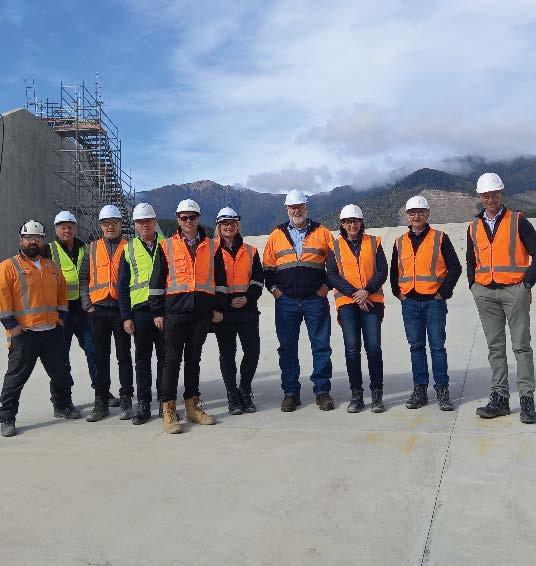

experienced people in the design side of the project, and even on the board of the dam company was dam construction expertise. Some of it came later in the project though and that means the project might have been delivered differently and been able to be completed faster if that expertise had been available from the outset and throughout the project.”
For irrigators, he says it would have been considerably cheaper to build on-farm water storage, but firstly, that would have resulted in numerous ponds across the Waimea Plains and taken up a lot of productive land cumulatively in order to have the reliability to grow horticulture crops.
Because it is expensive water, the operating costs per annum will likely drive some changes in land use
Secondly, it would not have solved the water security issue for the entire community into the future. Whereas the dam has already supported developments such as Richmond West which he says would not have been able to go ahead without a projected future water supply, and provides water security for urban areas from Richmond to as far as Mapua. Just prior to the dam releasing water for the first time from the smaller of three permanent dispersing valves
at the beginning of March, many of the urban communities including Richmond had reached Phase E water restrictions which meant households were not allowed to even water their vegetable garden from a hose. The council suggested they place a bucket in the shower to collect water.
When water was released from just one of the dam’s three valves at the beginning of March, those restrictions were instantly lifted in most areas and once again residents could water their gardens, wash their cars – and irrigate their crops and land to 100 percent of their consented maximum water take limit under pre-dam conditions.
A dam was undoubtedly the way to go, says Bruno, and though there have constantly been some grumblings from members of the community about the need for a dam and its costs, he thinks it is a vocal minority.
“The cost blowouts have not been ideal, but this scheme is still a reasonably viable one for the whole of the region.
“It wasn’t strictly about a return on investment because I can tell you that as an investment it stacks up very poorly. But it provides security to those existing growers, and I think for the future land users on the Waimea Plains it means that there will be potentially more demand for land here because the water reliability will be as good as anywhere else – or better than a number of places.”
At the beginning of the project, it was suggested the operating costs would be about $500 per hectare per year, but that has risen to about $1,050 plus GST per hectare this season.
The Irrigation NZ board with the Waimea Dam chair, chief executive and ops managers. Photo courtesy of Irrigation NZBecause it is expensive water, he says the operating costs per annum will likely drive some changes in land use toward more intensive horticulture crops. Only three dairy farms remain on the Waimea Plains and they have long accepted dairying does not have a long-term future there.
Now that the dam is flowing, Bruno says there is the potential to sell the surplus shares held by Century Water to irrigate a further 2300ha and as more people join the scheme, the scheme gets cheaper.
The dam was built with the capacity to support about 5000ha and Waimea Water says further uptake will be focussed on unaffiliated and partially affiliated area in the zone of effect, with some potential to draw water from the zone to areas on the fringe.
The Waimea Community Dam is not your typical dam that pipes water to where it is needed. There are no pipes leading from the dam. Instead, it releases water into the river and that will recharge the aquifers where bores take water. Bruno acknowledges it will now be watched by other regions to see how it goes through severe droughts, and whether irrigators and urban supply do get the water they need.
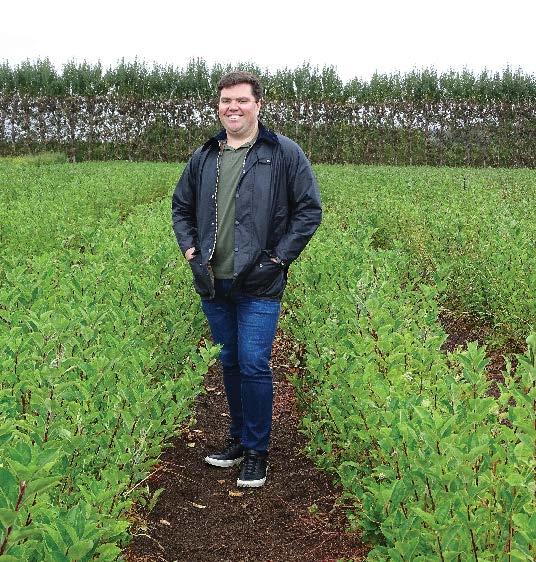


Berti offers the best mulcher for the finest mulch. They have double internal counter combs which reduce prunings to a very fine mulch. The finer the mulch, the less chance of disease.
Bruno Simpson from Waimea Nurseries wears a lot of hats: as a grower and irrigator he is a Waimea Irrigators’ representative, plus deputy chair of Waimea Water, and a director of Century Water.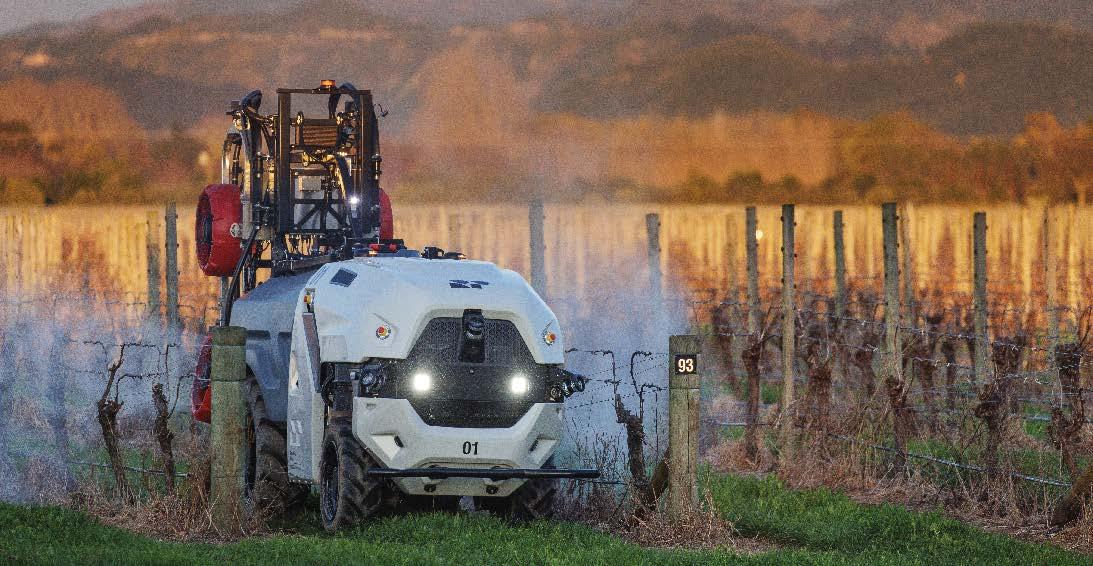
As New Zealand apple orchardists transition to 2D trellis growing systems, the demand for autonomous orchard vehicles is increasing.
Now Croplands, Nufarm’s spray equipment platform, and Robotics Plus, a New Zealand-based agritech company, have joined forces to bring the Robotics Plus Prospr multi-use autonomous vehicles to the Australian and New Zealand horticulture market.
Robotics Plus specialises in the design and build of robotics, AI (artificial intelligence), and autonomous machines, and Croplands has more than 50 years of experience in world-leading spraying solutions.
Elaine FisherSean Mulvaney, general manager Croplands, says, “We are proud to partner with Robotics Plus on the design and manufacture of world-leading Quantum sprayer modules to integrate onto Prospr.
Prospr is designed to significantly increase efficiency across a variety of tasks and alleviate labour challenges, with capabilities including automated intelligent spraying.
Growers are innovators, and they are looking at different ways to transform and grow for automation

With a spray trial on this vineyard, the autonomous vehicles can turn on their rear axle with a minimum headland requirement of 7.1 metres for row-to-row turning. Minimum row spacing is 1.85 metres
“Our focus on bringing emerging solutions to the market continues with the opportunity to distribute Prospr and a range of sprayer attachments across Australia and New Zealand.”
Prospr is ideally suited to vineyards and tree crops such as apples, and one person can operate several machines by monitoring them from the edges of the orchard or vineyard. Among the first to use the vehicles commercially is Treasury Wine Estates in Marlborough which has two Prospr machines in operation.
We’ve spent a lot of time in the field learning about different environments to develop technology that can solve problems in different environments
Steve Saunders, co-founder and chief executive Robotics Plus, says, “Growers are innovators, and they are looking at different ways to transform and grow for automation.”
He emphasises that Prospr can operate around the clock, and when it comes to spraying, autonomous vehicles keep people out of the spray environment.
“With more units in the field, the AI is continuing to learn and develop as it encounters new features and operating environments. If we find a new row structure or obstacle, we can respond to them and build wins quickly. We also monitor future growing systems to ensure we can support them.
“We are seeing more demand for connected machinery, and are excited to provide our customers with data-driven insights about how their Prosprs are performing for their operations.”
The Q Series sprayers developed by Robotics Plus in conjunction with Croplands, allow growers to deploy a range of sprayer configurations, adapting to various crop types and growing systems. The Q4 / Q6 sprayers have two or three fans per side designed for either vine or tree crops.
The Prospr vehicle can accommodate interchangeable fully electric tools for different orchard management tasks, and a range of others, such as weeders for vineyards and apple orchards, are under development.
“Developing automation for the field is complex and has many inherent challenges. Orchards can be configured in many different ways, including shapes, row widths, posts and growing structures. Then you throw in slopes and different ground conditions. We’ve spent a lot of time in the field learning about different environments to develop technology that can solve problems in different environments.
“Our interactions with initial customers have been partnerships, with growers sharing their experiences and how they would like to see technology develop.
“Together, we have challenged older processes and Robotics Plus has provided scope on what benefits automation can deliver, integrating key pieces of customer feedback into our product roadmaps,” says Steve.


Horticulture is a positive industry to work in given the health benefits of the fresh fruit and vegetables grown in New Zealand.
“Encouraging, educating and enabling people, especially school children, to eat more fruit and vegetables, means that this is the ideal industry for me to work in,” says Carmel Ireland, project manager at United Fresh, who is also a member of Women in Horticulture (WiH).
Through her role at United Fresh, Carmel is involved in the Fruit in Schools (FIS) programme, part of the Fruit and Vegetables in Schools Programme, which provides fruit to more than 125,000 school students and staff each school day, equating to 127 million servings of fresh fruit and vegetables each year.
Elaine FisherThe programme, which delivers fruit and vegetables to 566 schools across 21 regions in New Zealand, is one Carmel cares deeply about.
“The programme has been running since 2005. Its longterm impacts include helping to address equity issues in our communities by making fresh fruit and vegetables accessible to children. It also helps normalise snacking on fresh fruit and vegetables so that children are treating them as a normal part of their diet.”
A recent independent evaluation conducted by Quigley and Watts on behalf of the 5+ A Day Charitable Trust which supports the Te Whatu Ora funded initiative, found that FIS rated as the most effective initiative at supporting a healthy kura or school environment.
Carmel says the survey’s feedback from principals was hugely affirming, but also showed the desperate need that still existed in the community.
“Food insecurity has reached even greater heights than before the (Covid-19) pandemic. The review shows just how hard it has become for whānau to put nutritious food on the table every day, with 93 percent of principals saying FIS supported them to feed hungry tamariki,” she says.
Principals interviewed for the evaluation highlighted that FIS helped them assist whānau with the high cost of living. Not only was some of the stress of providing fresh produce for tamariki removed, but kura were also able to assist struggling whānau by sending home excess fruit from time to time.
The programme delivers fruit and vegetables to 566 schools across 21 regions in New Zealand
Carmel joined United Fresh in 2005, after working alongside United Fresh general manager Paula Dudley on a 5+ A Day programme in early childhood education centres, for the Heart Foundation.
“I was really impressed by the work United Fresh and 5+ A Day was doing and when an opportunity arose to join the team, I jumped at it. Paula has become a mentor for me in my career and I enjoy being part of the United Fresh all-woman team.”
A career in horticulture was not on Carmel’s radar when as a young and talented track and field athlete, she gained a scholarship to study for a Bachelor of Science (BSc) Kinesiology and Exercise Science at the University of Illinois.
“It was a wonderful experience. Through playing a lot of sport, I was interested in studying health and fitness and their impacts on movement and performance, so took a nutrition paper as part of my degree,” says Carmel who grew up in west Auckland.

Back in New Zealand, Carmel decided to continue her education and interest in nutrition, completing a postgraduate degree in Public Health at the University of Auckland in 2002, followed by a certificate in Pacific Nutrition at the Auckland Institute of Technology in 2005.
While horticulture was not her first choice of career, Carmel is now a strong advocate for the industry.

“Horticulture is a great industry to work in. It offers a lot of opportunities for women, including through the Women in Horticulture group which is supporting and empowering women in the industry and providing connections for women in the regions. We need more women to work in horticulture and to progress to leadership roles.”
United Fresh took over the leadership of Women in Horticulture (WiH) in April 2023 and held its first workshop late last year.
“The feeling in the room at the first workshop was so positive and supportive, we plan to run more events in 2024.”



With the kiwifruit harvest in full swing, volumes of Zespri RubyRedTM Kiwifruit, the first variety harvested, are expected to have tripled, surpassing the milestone one million trays.
The Orchardist staff
With the kiwifruit harvest in full swing, volumes of Zespri RubyRedTM Kiwifruit, the first variety harvested, are expected to have tripled, hitting the milestone one million trays in early March.
The berry-like kiwifruit is available for domestic consumers and has also been shipped to markets throughout the Asia Pacific including Japan, China, Taiwan and Singapore, and for the first time this season to South Korea, Malaysia and Hong Kong.
Marketing campaigns will include in-store activations and sampling, as well as digital and social campaigns using influencers to highlight the distinctive flavour as well as the health benefits of RubyRed.
RubyRed was developed in partnership with Plant & Food Research. It has a smaller natural fruit size and a shorter shelf life compared to other Zespri varieties.
“We continue to build our knowledge of Zespri RubyRed Kiwifruit so we can meet the strong demand we’re seeing,” says Zespri chief executive officer Dan Mathieson, “and this includes gathering consumer feedback to drive strong per tray returns in our markets and maximise the value we can return for our RubyRed growers.
“It’s also a variety which is helping bring new and younger consumers to the kiwifruit category, and we believe increased production in the coming years will support its growth in high value markets.

In early March Zespri’s first 2024 charter shipment departed the Port of Tauranga on the vessel Kowhai to arrive in Shanghai at the end of March, including 15 containers of RubyRed. Photo by Jamie Troughton, Dscribe Media, courtesy of Zespri
“Our focus in 2024 must again be on continuing the important progress we’ve made in lifting our fruit quality and delivering consistently high-quality fruit throughout the season,” Dan says.
After the challenges of the last two seasons, more settled weather for much of the country has meant that Green, SunGoldTM and RubyRed varieties are forecast to ship a significantly higher volume of 193 million trays, up from the 133 million trays exported last year.
Zespri chief operating officer Jason Te Brake reports a positive growing season, despite slightly later fruit maturity than hoped for.
“A key part of this is starting our season strongly and getting a good source of fruit to our customers so that we can capitalise on early sales opportunities and the strong consumer demand for our fruit, with our shipping programme and our longstanding partners playing a critical role. The weather hasn’t entirely played ball and we’re a bit behind schedule but are confident we can deliver the season well.”
In early March Zespri’s first 2024 charter shipment departed the Port of Tauranga on the vessel Kowhai, carrying 700,000 trays of SunGold as well as 15 containers of RubyRed. Both the Kowhai and the season’s second charter the Solent Star are expected to reach Shanghai at the end of March.
Zespri expects to charter 63 vessels this season, up from 51 last year. The programme comprises three services to Northern Europe, 14 to the Mediterranean, four to North America’s West Coast and 42 to Asia, with the remaining volume to be shipped using container services.

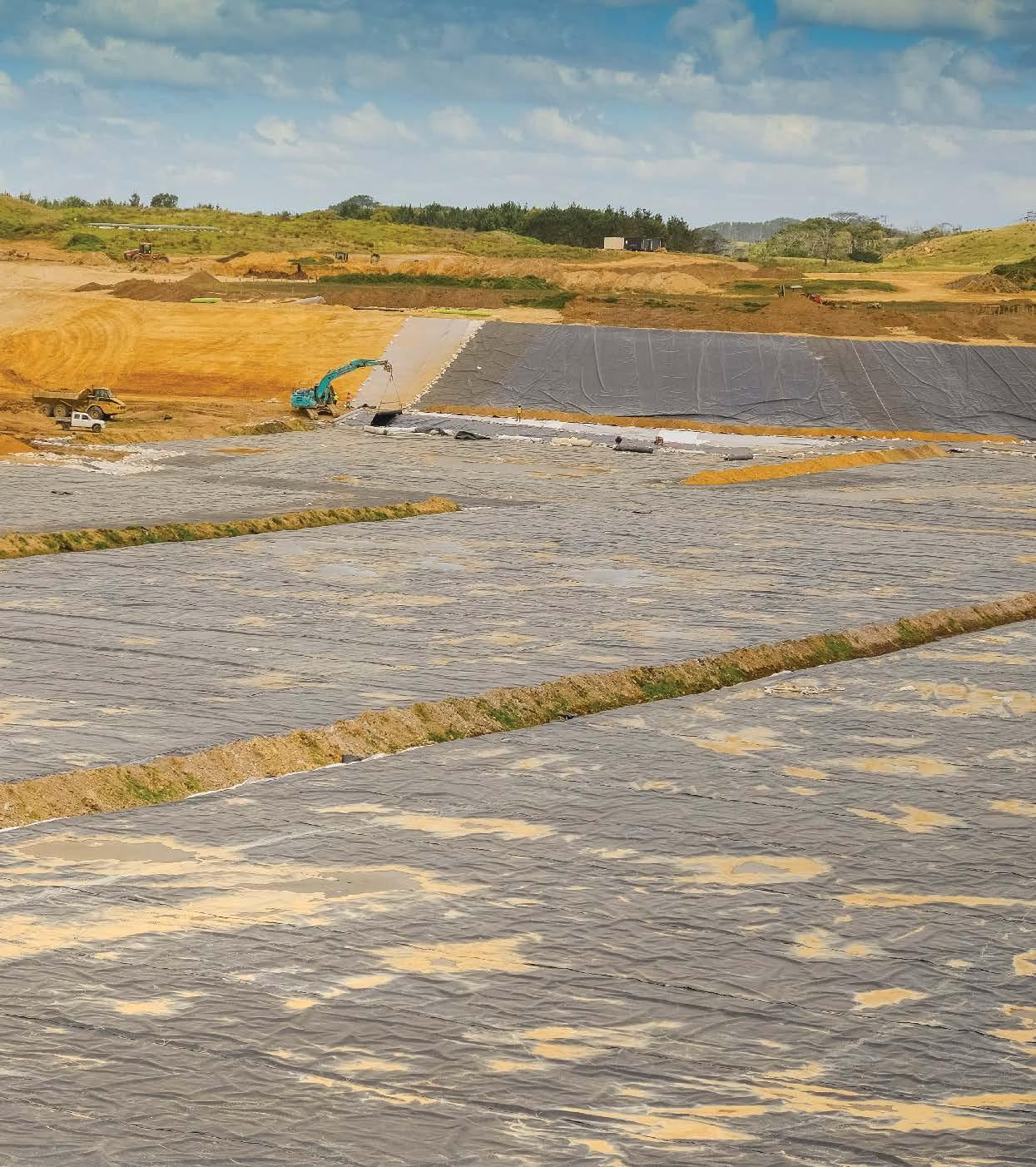 Te Tai Tokerau water project in Northland is a large storage project about halfway through to completion
Photo by Trefor Ward
Te Tai Tokerau water project in Northland is a large storage project about halfway through to completion
Photo by Trefor Ward

Canterbury has more than 60 percent of the country’s irrigated farm land, mostly for dairy. Highlighted in red are the large community storage schemes on the Rangitata River on the left and on-farm ponds. New Zealand has more than 3000 on-farm ponds according to an Irrigation NZ estimate. Image courtesy of Aqualinc
Water storage options for resilience and unlocking growth.
Dr Andrew Dark : Aqualinc Research
While horticultural crops can be grown without irrigation in some parts of New Zealand (and currently are, in some cases), access to a reliable irrigation water source provides insurance against crop loss in severe droughts, and confidence that crop quantity and quality can be managed consistently (although there are other factors that can still contribute).
In general, New Zealand has abundant water resources, but from an irrigation perspective the water is often in the wrong place at the wrong time. Water storage is a vital tool to correct the mismatch between supply and demand.
For new developments requiring external capital, investment in a reliable water supply can help to unlock much greater investment in the development as a whole. While there is potentially irrigable land available in regions suitable for development of new high-value horticulture, in
many cases the “easy” water is already allocated, and new developments may need to rely on less reliable sources with higher cease-take flows.
in a reliable water supply can help to unlock much greater investment in the development
Over time, changes in climate and the regulatory environment are likely to result in less reliable access to water for existing water users: new regional plans or renewal of resource consents may result in changes to allocation rules.
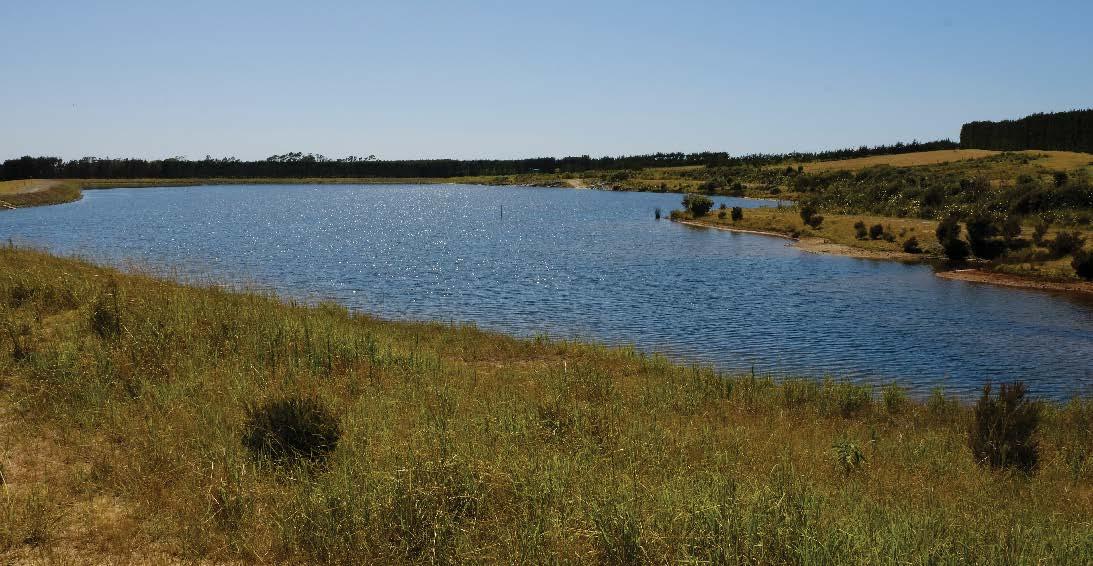
Groundwater, traditionally thought of as a completely reliable water source (if wells are deep enough), may become subject to low-flow restrictions in future as more thought is focussed on the hydrological system as a whole. The importance of water storage development for highvalue horticulture has been a consistent message from former and current governments. The Ministry for Primary Industries’ Fit for a Better World roadmap for the primary sector aims to support development of water storage solutions that enable productivity increases (i.e. greater revenue per hectare, or per m3 of water used for irrigation) and build climate resilience. As the value of the production supported by irrigation increases, so too does the potential loss from water supply shortages. Therefore, it’s critical to get the fundamental design of a storage-based water supply system right.
Getting the volume of water storage right is the first step. This should come before decisions are made about the location or type of storage. Correctly sizing storage requires an understanding of:
• the available water supply, and how it varies over time (month to month and year to year),
• the water demand profile of the existing or proposed crop(s),
• the supply reliability requirements.
Determining the required supply reliability, or security of supply, involves understanding what water supply deficits are acceptable, in terms of frequency, duration, timing and severity. There is no one-size-fits-all answer, and a single percentage metric doesn’t tell the full story about reliability.
It ultimately comes down to risk appetite. Horticulture doesn’t have the option of de-stocking or buying in supplementary feed as is possible in a livestock-based farm system, which elevates the importance of a reliable water supply.
Scenario analysis using models that simulate water supply, demand and storage volume and refill capacity using historical climate and river flow records can tell us how much water would have been required to provide a particular level of supply reliability in historic dry years. Climate change projections can be factored into this type of modelling; for larger developments with a long design life, or where inter-generational planning is part of the picture, it is important to factor in demands and water availability under future climates.
A mix of community scheme and on-farm storage ispotentially an attractive option that provides greater flexibility
Commissioning a modelling study to determine the size an on-farm storage pond may feel like an unnecessary expense, but when the consequences of not having water at critical points in the growing season are high, is it wise to rely on a rule of thumb for sizing storage, particularly in the context of a changing climate? Conversely, a storage sized on rule of thumb could be oversized, resulting in unnecessary capital
and maintenance expenses and (in the case of on-farm storage) too much land being taken out of production.
Broadly speaking, there are two options for water storage: community storage, where the storage and associated infrastructure and resource consents are owned by a company (or similar ownership structure) and water users are shareholders in the water supply entity, or on-farm storage where individuals own and operate the infrastructure.
Community schemes typically have a lower cost per m3 of water stored or hectare irrigated due to economies of scale. Schemes don’t need to service tens of thousands of hectares to be viable: for high-value crops there can be worthwhile economies of scale for a few hundred hectares spread over multiple properties.
Establishing community water supply schemes is not without difficulty though, even on a relatively small scale. Broad community support is required from water users and other partners. Obtaining resource consents is more difficult: larger water takes and storage sites attract more scrutiny in the consenting process. The new government has introduced legislation to fast-track consenting for major infrastructure projects, and funding for regional infrastructure development. It remains to be seen where all this lands in terms of rural water infrastructure. Water
storage in Northland was consented under a post-covid consenting fast-track process, and the provincial growth fund supported water storage projects under the previous government, so there is precedent.
Once established, operation and maintenance of a community scheme is taken care of by the scheme company. This includes resource consent and dam safety compliance, which have the potential to be a significant headache if the infrastructure is owned by individuals.
While in the past schemes tended to provide water on a “use it or lose it” roster basis, it is more common now for water to be ordered on demand via a web portal. Depending on the scheme’s share structure and water charging method, it may be possible for individual water users to determine their own level of reliability from the scheme (within the constraints of the scheme’s overall storage volume and resource consents).
Other benefits of community schemes include the potential to provide water for non-irrigation uses (e.g. potable supply, firefighting), environmental flow enhancements, and recreation. It may be possible to store water at higher elevations, allowing it to be delivered under pressure. Suitable sites for community-scale storage can be a scarce resource in some areas though, once engineering and geological constraints are factored in.
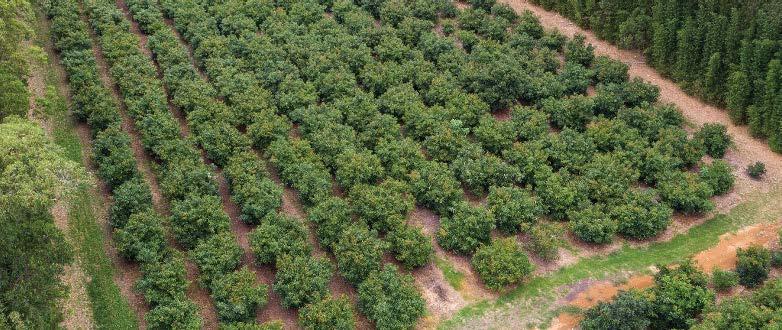
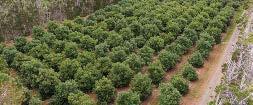

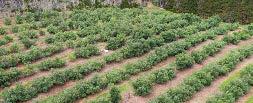
JR’s Papawai Orchard, Greytown is a fully integrated apple and pear business exporting produce under recognized brands ECCO and Capital to customers throughout the USA, UK, Europe and Asia.
• 127.9942ha, 85ha under protective cover
• Full packhouse, Compac grading system, cool storage and smart fresh technology
• MAF certified exporting from Wellington Port
• Accommodation for 70+ seasonal workers, strong relationship and agreements guaranteeing staff availability each year
•Existing management structure able to remain allowing for a smooth transition to the new owner
bayleys.co.nz/3150867
It’s been a tough time down on the avocado farm. But the world loves avocados and the NZ industry will rebound in a major way. New Zealand avocado exporters’ market focus is now away from the oversupplied Australian market, with volume developing rapidly into Asia and North America. Asia’s 3.6 billion people consume on average 0.21kg avocado per annum. The Australians consume over 5kg per annum. The opportunity is clear. This four-orchard portfolio comprises 33.43 (more or less) canopy hectares. Of these, 22.23 hectares are either in a high production state or are redeveloped blocks moving to high levels of production. After investing significant capital in the redevelopment of the orchards, the owners decision is to exit the business. Their loss can be your gain. Most orchard blocks are on track for 20 ton plus per hectare production from a high-density lower production cost operating model. This is your opportunity to enter the industry or increase your current production level on favorable terms, at a level of capital likely to support attractive investment returns as the industry rebounds. As an added incentive an option exists for a new owner to lease the orchards to industry distribution entities. This is a short duration tender closing on the 18th April 2024. If you are serious about investing in an industry for medium term capital and operating reward, call now. Bayleys.co.nz/1003921

Flexi Tanks NZ’s bladder storage is found throughout New Zealand, such as these (1 million litres each) at a Tolaga Bay covered crop operation. Flexi Tanks NZ’s Anton Meier says the installation takes just hours to complete. The tanks, manufactured by France’s Labaronne since 1959, have proven extremely tough and long-lasting. Photo by Flexi Tanks NZ
On-farm storage puts all decisions and responsibilities related to water supply in the hands of the landowner. In most cases it will be easier to obtain the relevant consents and get storage constructed without the need for input from multiple stakeholders. On-farm storage can be sized to the requirements of the crop(s) being grown and the individual grower’s risk appetite. Typically, it is less efficient in terms of both the capital cost and the area of land required per m3 of water stored. Unless there is suitable unproductive land (such as a gully that can be dammed), on-farm storage normally requires taking land out of production. Refill capacity can be a constraint, in terms of both consenting and infrastructure. After using stored water, the ideal situation is to be able to refill storage immediately, so that it’s ready to go again when needed.
New dam safety regulations commence in May this year, applicable for dams 4 m or higher storing more than 20,000 m3, or 1 m or higher storing more than 40,000 m3
A mix of community scheme and on-farm storage is potentially an attractive option that provides greater flexibility. This combination can provide a baseline level of reliability,
potentially lowering the bar for investment in the scheme, while allowing individual growers to tailor their overall water supply security to their own needs or risk appetite.
For growers contemplating on-farm storage, there are a range of potential options. Ponds are often formed by excavating material from the pond site and using it to form embankments. This has the advantage of utilising space below the natural ground level to store water, but the depth to the water table (and how this varies over time) may be a constraint. To avoid losing water to ground, a synthetic liner may be required, depending on the suitability as a lining layer of natural materials available in the area. New dam safety regulations commence in May this year, applicable for dams 4 m or higher storing more than 20,000 m3, or 1 m or higher storing more than 40,000 m3. For some owners of storage ponds, this will create additional costs and workload to ensure compliance.
Floating solar panels on water storage ponds is an idea that has gained some traction recently. This can reduce evaporative losses and provide shading that helps prevent weed and algae growth. It provides the opportunity to use the pond’s surface area to generate power for on-farm use and / or export to the grid, which can partly offset the lost production from the pond area. The efficiency of the solar panels may be greater than panels mounted on land or buildings due to the cooling effect of the water mass beneath.


Above-ground tanks may be a viable option for smaller irrigated areas or where there are space constraints, as there can be some flexibility with layout. Tanks require a flat, stable area for installation, and some larger options have specific foundation design requirements. Off-the-shelf plastic tanks typically have a maximum size of 30 m3 per tank (which doesn’t go far by itself in terms of improving supply reliability), but multiple tanks can be connected as part of a storage solution and the total storage can be scaled up relatively easily by adding additional tanks. Larger tanks requiring more specific design and on-site installation can hold up to 6000 m3. Key advantages of using tanks for water storage include reduced evaporative losses and improved water quality: they are less prone to algal growth and fouling by wildlife (although larger tanks may not include a roof / cover in their standard design and pricing).
Key advantages of using tanks for water storage include reduced evaporative losses and improved water quality
Flexible bladders are also potentially a cost-effective solution for smaller volumes, holding up to 2000 m3 each. These are easily installed and require minimal site preparation. Bladders have similar advantages to tanks
New Zealand has abundant water resources but from an irrigation perspective the water is often in the wrong place at the wrong time
in terms of evaporative losses and water quality. They are potentially vulnerable to damage through punctures and tears.
Managed aquifer recharge (MAR) and aquifer storage and recovery (ASR) have received some attention as alternatives to surface storage. These shouldn’t be written off as part of a catchment-scale solution, but their applicability is highly location-specific and they need a thorough understanding of the groundwater system and how it interacts with surface water, which is lacking in many areas.
Many parts of New Zealand have experienced extremely dry conditions this summer, which are now extending into autumn. This is likely to be focussing people’s thinking on options for more resilient water supplies. Storage will be an attractive option in many cases for improving and future-proofing water supply security, but it’s important to not rush into it without careful investigation and design. Although some storage is always going to be better than none, the level of investment required justifies the investigation effort to get it right, and you’ll sleep better at night knowing that water is likely to be there when you need it.
Believed to be the only floating solar array in operation in New Zealand, Watercare’s Rosedale Wastewater Treatment Plant in Albany is a great example of using a pond’s surface area to generate power for onfarm use and / or export to the grid, which can partly offset the lost production from the pond area. Photo courtesy of Watercare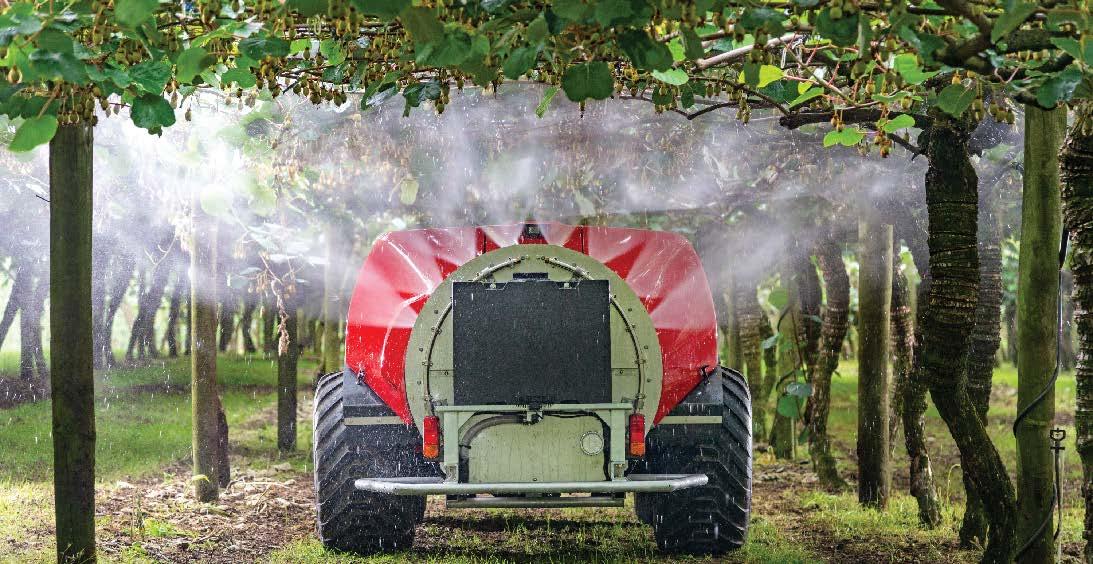
In recognition that spray drift incidents and community concerns can erode the industry’s social licence, New Zealand Kiwifruit Growers Incorporated (NZKGI) started a conversation in 2021 regarding a Shelter Mandate for the industry.
Kathy Mason : NZKGI senior policy advisorIt is fair to say that the process of developing a Shelter Mandate has been challenging, and it is now time to pause and reflect on next steps.
The kiwifruit industry’s social licence to operate can be likened to a ‘bank of goodwill’ that needs to be fostered so that the industry can continue to function effectively. This means complying with regulatory requirements as a minimum, and also listening to our communities and responding accordingly.
Agrichemical spraying has its own unique social licence challenges. Whereas some risks are clearly understood
by most people – e.g. falling off a roof – some people find it more difficult to rationalise the risk of agrichemical spraying, often due to a deeply held fear of the unknown, which in some cases may be driven by a mistrust of science and/or fuelled by misinformation.
Within any community there is a range of opinions and attitudes towards agrichemical spraying. At one end of the scale, some people have no concerns at all, but some of them will change their views if they or others in their community feel that they, or their environment, is being affected by spraying. At the other end of the scale, some people would prefer that no spraying of any sort is carried out ever.
For most people, provided that regulatory requirements are complied with, there is a degree of acceptance of agrichemical spraying. This is not surprising, because the rules exist to protect people and the environment from adverse effects.
The industry understands the absolute need for growers to comply. This is why NZ Kiwifruit Growers has a spray hotline, and also why we support regional councils to enforce the rules. However, even with 100 percent compliance, there will still be some people who will continue to have concerns.
We are very aware that members of the public have the potential to lobby which may result in tougher and possibly unworkable controls, and in the worst case, the phasing out of essential agrichemicals altogether. For this reason, the industry continues to proactively focus on a suite of measures to maintain its social licence, including selfregulation, research, continuous improvement and education.
simple single layer artificial shelter structures meet this target, with typical trimmed living shelter belts capable of achieving drift risk reductions of over 95 percent.

It is important to acknowledge the underlying risks of spray drift associated with kiwifruit spraying operations. The greatest risk of off-target losses occurs when the vines are dormant and while the crop canopy develops in the spring. Once the crop canopy has developed, almost all of the applied spray can be expected to land on that target. Growers manage risks to sensitive areas within and outside their orchards by timing spraying operations relative to wind conditions and how they operate sprayers when close to sensitive areas like property boundaries. Shelter provides an incredibly useful ‘last line of defence’ to mitigate potential off-target losses – partly by slowing wind speeds which assists spray droplet fallout within the orchard, and partly by directly collecting droplets that make it that far.
The significant role that natural and artificial shelter plays in protecting kiwifruit orchards from high winds has long been recognised by the industry. In addition to its crop protection role, shelter also has a considerable and well documented role as a spray drift mitigation tool. It is therefore not surprising that a mapping exercise in 2021 demonstrated that 97 percent of kiwifruit growers have some type of shelter.
It is well recognised that different types and qualities of shelter vary in their ability to mitigate spray drift. ‘Effective shelter’ is defined as shelter that can provide at least an 80 percent reduction in any spray droplets (spray drift) that reach the shelter from orchard spray applications. Most
With this in mind, and as part of its response to the Environmental Protection Authority’s reassessment of hydrogen cyanamide (more commonly known as HiCane), NZ Kiwifruit Growers started a conversation around mandating effective shelter across the industry in 2021. This has evolved into a working document that outlines minimum standards for shelter along sensitive area boundaries. The side panel provides a summary of the current requirements.
Growers have been advised that, to supply Zespri, these standards will apply at the time of the 2025 Zespri GAP (Good Agricultural Practice) audit for the 2026 season, or a 30m buffer zone will apply. Where there are valid reasons for not having shelter, growers have the option of applying for a dispensation.
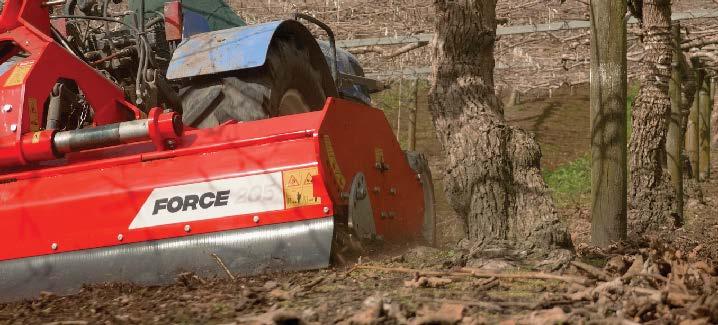
Where?
Along any orchard boundary which borders land title of a sensitive area, if rows are to be sprayed within 30 metres of that land title boundary.
Sensitive areas are:
• Public water supply catchments and intakes
• Rivers, streams, lakes and wetlands
• Public areas that members of the public may use, e.g. cycleways, walking tracks, footpaths, parks and reserves
• Significant Natural Areas
• Organic or other sensitive crops
• Schools, early childhood centres, education camps and community facilities
• Marae
• Public roads with formed footpaths
• Golf courses
• High traffic roads.
Along any orchard boundary where vines to be sprayed are within 50 metres of the physical edge of:
• Residential houses
• Commercial buildings
How?
• Height minimum 5 metres – for natural shelters this is a minimum height when trimmed.
• Natural Shelter – Evergreen varieties that are fast-growing and pest resistant with a porosity to ensure a significant reduction in spray drift while not being so dense to cause drift to move under or over it.
• Artificial shelter should meet one of the following, while taking into account the likelihood of high winds:
– Single layer 20 percent porosity (which provides a good visual screen but may be affected by high winds
– Single and double layer combination:
– A double layer from ground to a minimum height of 3 metres, either 50 percent + 80 percent porosity or 50 percent + 50 percent porosity, and
– A single layer (minimum 50 percent porosity) on the remaining two metres at the top
– Double layer: two layers of 50 percent porosity to a minimum height of 5 metres
– Layers must be separated by minimum 100 millimetres.
Feedback on the working document so far has been mixed. While many growers support a Shelter Mandate of some sort, the general view is that the current draft goes well beyond what was originally anticipated and contributes to over-regulation. Some growers have said that it was never anticipated that serious money would need to be spent to retrofit their shelter to meet the requirements. In addition, growers who for various reasons are unable to install effective shelter due to powerlines, neighbour preferences and so on, are concerned that the Shelter Mandate is unhelpful. Some growers have stated that the benefits of overhead and enclosed shelter have been ignored. Artificial shelter designers have also questioned the workability of the current requirements.
In the light of this feedback, and other continuous improvement initiatives that have emerged since the Shelter Mandate was initiated, it is time for the industry to pause and reflect on whether the currently proposed minimal standards for shelter remain appropriate.
Recently, Dr David Manktelow has been developing a multisector project with the New Zealand Agrichemical Education Trust to deliver a documented spraying risk assessment and implement a real-time spray drift mitigation process. This system sums the expected contributions to spray drift risks (positive or negative against a starting set of conditions) of a series of independent factors (e.g. spray quality, adjuvant use, wind speed, presence of effective shelter, presence of overhead netting) that are relevant to different crop and spray application systems. The intention is to deliver a management toolbox that will be practically used by growers to identify and manage spray drift risks in the real world.
Another example is a government and industry-funded two-year research project that commenced in late 2023. This project is exploring the use of Smart Apply® spray application technology in kiwifruit, by using LiDAR (Light Detection and Ranging laser scanning technology) to sense the spraying target and adjust the outputs of individual nozzles to only spray the target. Based on experience in other crops, it has the potential to deliver significant reductions in the volume of spray required. Experience on other crops suggest that turning off spraying in gaps massively reduces spray drift.
Where to next for the Shelter Mandate?
In light of grower feedback on the Shelter Mandate and emerging continuous improvement initiatives, it is time to pause and reflect on next steps for the Shelter Mandate.
Growers have sent a very clear message that overregulation is unhelpful, and that having the right mix of useful tools and practical guidance is essential to achieving optimal outcomes.
While the low level of verified complaints suggests that the grower education and self-enforcement that is being carried out by the industry is working well, we know that we can always do better. In that regard, the drift management toolbox will help all growers to further improve their practices through appropriate recognition of site-specific factors on their own orchards.
The future use of Smart Apply spray application has real potential to help those people who are concerned about sprays in general, by reducing the volume applied.
While the optimal outcome is for all growers to have effective shelter where they are able, some questions remain as to whether effective shelter should be mandated for all current and future kiwifruit orchards, and if so, where.
We know that some members of the public will complain when they see a sprayer operating regardless of whether the agrichemical is hazardous or not. Some growers see this as a threat to the industry’s social licence and have identified that the purpose of the Shelter Mandate should only be to screen views from roadsides.
Doubtless this will be the subject of ongoing debate as we further consider the purpose and ongoing development of the Shelter Mandate in the context of other possible industry initiatives, including greater penalties for noncompliance and an increased focus on education.
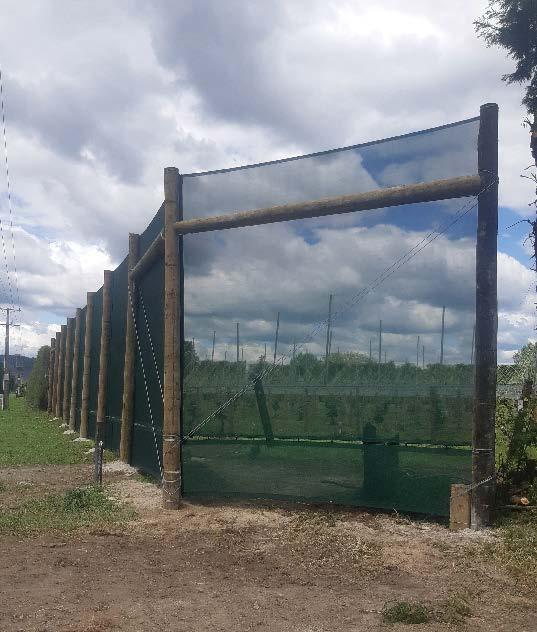
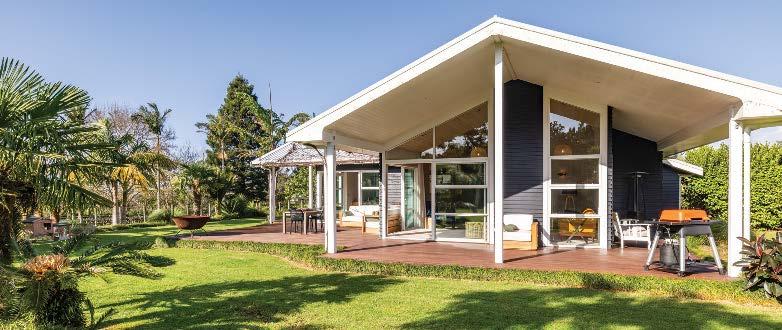



Greytown
JR’s Papawai Orchard, Greytown is a fully integrated apple and pear business exporting produce under recognized brands ECCO and Capital to customers throughout the USA, UK, Europe and Asia.
• 127.9942ha, 85ha under protective cover
• Full packhouse, Compac grading system, cool storage and smart fresh technology
• MAF certified exporting from Wellington Port
• Accommodation for 70+ seasonal workers, strong relationship and agreements guaranteeing staff availability each year
•Existing management structure able to remain allowing for a smooth transition to the new owner
Live in beautiful Kerikeri. Be your own boss whilst earning an exceedingly high income. This is it! Located just a few kilometers from Kerikeri town is this Scandinavian influenced home with amazing features such as high pine ceilings, stone feature walls, double glazing, three large bedrooms plus office, fabulous kitchen, generous decks and double garage. This is an exceptional home. And then comes the income and the life! The current owners have over several years established a highly successful export orchid growing business. Their busy time is over the winter months, and summertime is primarily leisure. Once you are the lucky owner your core work processes are to care for orchids within the hothouses until flowering starts in May. Once flowering starts its picking and packing into export boxes, and they are then off to the exporters. It’s a simple operation and easy to learn. The current owners will assist you with training and oversight. This is a financially proven business set up for big profit over the 2024 season. Net profit after owner wages and after all operating costs in 2023 was over $250,000. A similar result is forecast for this year when you can be the owner. This property and business will sell! Don’t miss an excellent opportunity for a new life and high income. Enquire now! Bayleys.co.nz/1003929
bayleys.co.nz/3150867

And how did it compare with a typical El Niño summer… El Niño, characterised by warmer sea temperatures near the equator in the eastern Pacific, varies in global intensity and impact. Growers in Gisborne and Hawke’s Bay typically expect dry summers under El Niño – but what happened this time?
A quirk of our current El Niño is that it occurred during a time when all global oceans were much, much warmer than normal – meaning that this El Niño didn’t really stand out from the crowd.
Additionally, we were coming out of a rare long-lived La Niña event, which research suggests can have lingering effects.
All of this likely affected the downstream effects of our El Niño.
Despite this oddity, it is still considered a strong event, the first in eight years. We measure El Niño strength through indices like ONI (Oceanic Niño Index) and MEI (Multivariate ENSO Index).
The former measures only sea surface temperature anomalies in the eastern tropical Pacific, and the latter measures a broader response which includes the atmosphere. This event peaked at 2.0°C in the ONI and 1.1 in the MEI.

To find comparable historical events (analogues) to this strong El Niño, we set a fairly high threshold of 1.5°C for the ONI, and 1.0 for the MEI. This generates eight comparable historical analogues since 1972.
Due to space considerations, and their long, consistent climate records, this article will just focus on statistics from Napier and Gisborne airports. We will compare against both the 30-year climate averages, and against our El Niño analogues.
December
Higher than normal air pressure sat just to the north and the east of the North Island, overall bringing a northwesterly wind anomaly. However, there were occasional fronts stalling over the upper North Island with high pressure building to the south, bringing a few rain events to Gisborne and Hawke’s Bay.
While there were no major individual rain events, Gisborne still had 100 mm of rain – (156 percent of normal). Meanwhile, Napier trickled in at near-average rainfall (49 mm versus 58 mm).
January
Higher than normal air pressure to the east of the North Island brought an anomalous northerly flow over the country. This made January the hottest month of the summer, but there were also a few rain events.

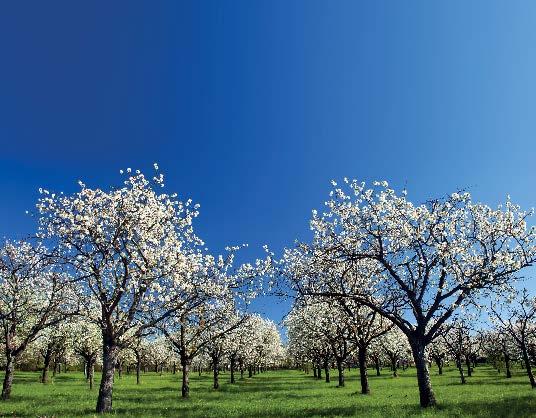
Similar to December, these resulted mainly from fronts stalling in the region, rather than moving through quickly, hence January was a wet month in both Napier (240 percent of normal) and Gisborne (180 percent of normal).
Outside of the rain events, there were numerous hot, dry days. Napier reported five days exceeding 30°C. While significant, it pales in comparison to the famous El Niño February of 1998 which recorded eleven days over 30°C.


With high pressure becoming dominant just to the north, and low pressure to the south, February brought about a significant change to the pattern compared with early and mid-summer.
It finally resulted in weather that many people closely associate with El Niño. Both Napier (42 percent) and Gisborne (47 percent) reported well below normal rainfall – this was Gisborne’s first below average rainfall month since August 2023.
Note: there are some missing years, which will slightly affect the moving average

In the text above we have compared monthly rainfall data with the 30-year climate averages. But how did summer 2023–2024 stand up next to our eight historical analogues? Clearly, both December and January were wetter than normal compared with climate averages, but more significantly so in comparison to the historical El Niño analogues. This story did not continue in February, where 2024 stands out as dry even by comparison to historic Niño events.

Warm days (>25°C) showed a modest increase on historical El Niño summers. This appears to be a pattern over the last decade or so, with the ten-year moving average showing a generally consistent upwards pattern almost regardless of El Niño/Niña status.
Summer 2023–2024 was uneven, and cannot be summed up as being dominated by one type of weather pattern. The unevenness appears even more accentuated when compared with our analogue years.


The long-term median is depicted as a white line, while the area between the 25th and 75th percentiles is shaded dark grey (i.e. 50 percent of all years lie in the dark grey shaded area). The area between the 10th and 90th percentiles is shaded light grey.
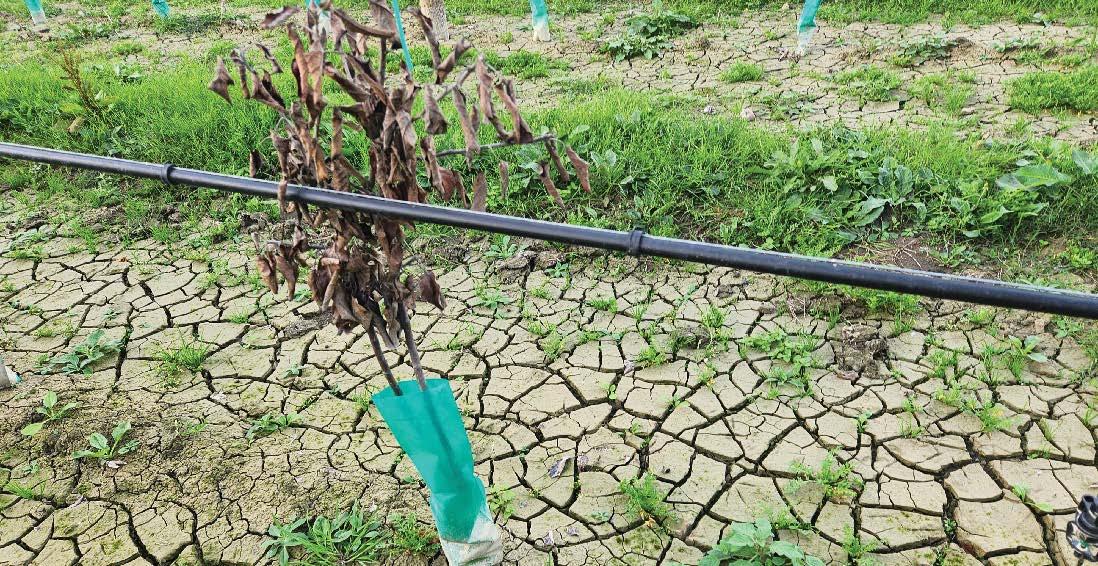
The best yields and fruit quality are generally achieved in hot dry years with high sunshine hours. However, rainfall, ET, soil type, effective rooting depths of plants, groundwater infiltration, crop type, development stage, vigour status and crop load all impact the volume of water and nutrition that plants need.
Jonathan Brookes : AgFirst Consultants Hawke’s BayIrrigation is needed to ensure plants still achieve optimum results when moisture levels in the rooting zone fall below optimum levels. Where irrigation supply is not guaranteed and plants are drought-stressed, growers run the risk of reduced fruit size and increased issues such as sun damage or biennial bearing susceptibility.
Growers need irrigation management strategies to ensure climatic resilience and sustainability of their orchard businesses. I do not believe there is one silver bullet, instead a list of things needing consideration to ensure we can continue to farm effectively and efficiently.
What do we know about crop water requirements?
Achieving excellence in irrigation management requires a good understanding of the current soil moisture status, crop effective rooting depth and the amount of root zone drying required to achieve the best outcomes.
Although tools such as IrriCalc can calculate a ‘best guess’ of expected need across generic crops for consent purposes, accuracy at the granularity of a specific block in a specific year is unlikely. Growers who watch the soil water bank, their crops and the weather are likely to use less water than model predictions in many seasons.

When finetuning irrigation management, a grower balances vigour control, canopy development, dry matter accumulation, fruit pressure, brix and size with the risks of sun damage and biennial bearing.
Vast improvements in water use efficiency are possible to growers through design, and finetuned irrigation management excellence. But to ensure success, a guaranteed irrigation supply is required. If irrigation supply is not guaranteed, growers generally react by overwatering, worried they need to use it or lose it.
What do we know about irrigation water use and environmental impacts?
Growers use irrigation to top up the shortfall needs of plants until winter rains fill up the soil moisture reserves for the next season. Most New Zealand growers aren’t growing in a highly deficit evapotranspiration versus rainfall desert situation, so the long-term balance is pretty good.
Good soil drainage increases the effective rooting depth of plants and is key for the high yielding, climatically robust properties we now grow on. Experience over the
last few ‘wet years’ shows poor drainage impacts orchard sustainability as much as limited irrigation supply, over the long term. Drainage does impact summer flows of surface water by quickly removing excess water in soils, that would have otherwise gradually replenished the water levels in streams and rivers in summer.
I do not believe there is one silver bullet, instead a list of things needing consideration
In New Zealand, water use by irrigators, industry and municipalities is generally from underground aquifers, recharged by (and connected to) river systems. Areas such as the Heretaunga Plains have deep underground aquifer systems, with water continuously running out to sea in offshore springs. Water abstraction percentage is low compared to the total volume available but it does have an impact. It is also important to understand that extreme dry events are likely to happen in the future with rivers running dry.
Online Orchard Irrigation Supplies
Call our experts 0800 130 905 www.irrigationexpress.co.nz
The well depth, confining layers and location from streams and river all have different impacts on the surface water and even the time scale that the effect takes place. Irrigation bans on wells don’t always guarantee significantly positive environmental outcomes, as stopping irrigation from well takes doesn’t always immediately transfer to drought-affected surface water levels.
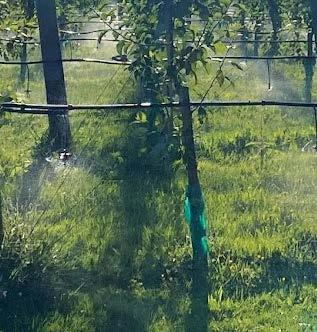
Excellent irrigation management requires a good understanding of the current soil moisture status, crop effective rooting depth and the amount of root zone drying required to achieve the best outcomes
We get the right amount of water most years. However, swamp draining and stopbank building (and subsequent rise in riverbeds) has reduced summer flow in rivers to levels where environmental impacts could, and probably will, ban irrigation use during times of drought. Bans are a crude tool with moderate positive effect, but a significant financial risk to ongoing sustainability, as shown in the financial impact work AgFirst carried out for TANK (Tūtaekurī, Ahuriri, Ngaruroro and Karamū water catchments) and the Hawke’s Bay Regional Council.
Apart from reinstating a few wetland areas and abstracting some shingle from high parts of the rivers, we cannot fundamentally reverse this. Stopbanks and drainage systems are improvements which allow us to manage floods, protect the entire community and provide food production security. Converting food production land back to an undrained natural state is not economically or socially realistic. The real challenge is to continue ensuring water use is not negatively impacting the environment for future generations.
If we want to have minimal environmental impact, we need to keep the summer flows high enough to sustain good river health. The solution is a focus on augmenting summer flows to replace our level of effect combined with a community focus on improving surface water quality, and finally growers looking to make a concerted effort on irrigation efficiency (only if bans are not a potential risk).
The real question is – how do we achieve this in a timely and financially sustainable manner?
Maximum effective rooting depth
Good soil drainage improves drought resistance. The deeper the roots the bigger the water bank, and longer before irrigation is needed. Most tree and vine crops are happy to have rooting systems to more than one metre if unrestricted. Excellent soil drainage, soil preparation at planting, quality irrigation management and overall soil best practice management all help improve plant effective rooting depth.
Target irrigation best practice to reduce overall use
Over-watering and under-watering ultimately cost growers’ money. It is important to understand appropriate plant stress levels, soil moisture content, current and future water needs. This relies on guaranteed supply.
Understand regional water availability alongside irrigation and drainage impacts (using real science)
Although a function of Regional Councils, water availability is critical to the future of every grower’s business. Regional water models must be ground-truthed, as assumptions in models often have some contingency margins included in them to give developers added confidence.
Form localised water user schemes
I am part of the development and management team for the Twyford district Water Users scheme. Different crop types have different needs at different times, and through such schemes growers learn to ‘share the spare’ during high and low points of crop need. Individual grower consents require some spare water to ensure they do not go over allocation, and the more this is combined the more efficient the water use can be as a region.
Augmented summer stream or river flows (Environmental management dams)
Environmental management dams look to be an essential long-term solution to ensure nature dry events do not create irrigation ban situations. The tough question is – who is going to pay for it? Although growers aren’t the only cause of the problem, they are part of it, and possibly have the most to lose in the short-term.
What is Onside?
New Zealand Avocado, Kiwifruit Vine Health, and New Zealand Apples and Pears have joined Biosecurity New Zealand under the Government Industry Agreement for Biosecurity Readiness and Response (GIA), to put Onside’s traceability technology to the test.
Onside is an orchard management app that simplifies compliance and makes health and safety and biosecurity easy on rural properties.
What are GIA and Onside doing together?
Biosecurity New Zealand, New Zealand Avocado, Kiwifruit Vine Health, New Zealand Apples and Pears, along with three other industry sector groups have signed a memorandum of understanding with Onside to trial their biosecurity traceability solution. As part of the six-month trial, growers can use Onside for free to capture movements on and off their properties, including potential high risk movements such as plants, people and equipment. This movement data is available for reporting to growers and property managers. It builds an anonymised networked view of people and risk goods moving between properties, which industry can access to enable rapid tracing should a biosecurity threat be identified at any property in the network.
Brad Siebert, CEO, NZ Avocado says “When growers use Onside to create biosecurity risk movements on, off and between their orchards, we can efficiently respond to incursions of diseases like Avocado sunblotch viroid (ASBVd)”.
What do growers get if they use Onside on their orchards? Taking part in the trial of Onside is free, and growers can:
• Simplify visitor management with the digital check-in app, and get notified when people are on your property.
• Download automatically created visitor and biosecurity records in a report format to meet biosecurity and compliance requirements such as GAP.
• Automatically maintain digital records of potential biosecurity risk movements.
• Create a digital map of your orchards, with boundaries, blocks and points of interest, and share this with every visitor via the mobile app.
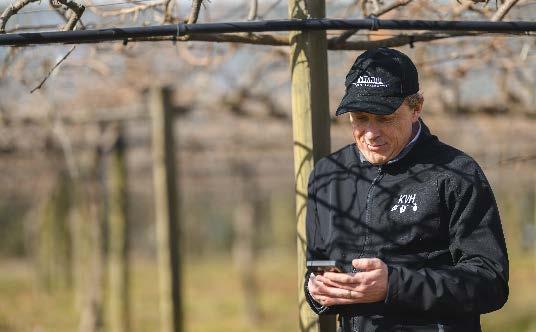
What has the response been from growers so far?
Onside and Kiwifruit Vine Health (KVH) have been partnered for over 18 months, engaging kiwifruit growers to adopt biosecurity measures and automate compliance in the day-to-day orchard operations with Onside’s mobile app. More than 740 kiwifruit orchards are now recording biosecurity movements in Onside.
Leanne Stewart, CEO, KVH says; “ The value of this is huge — being able to take action quickly can be the difference in saving orchards and livelihoods.”
“Popular feedback first-hand from growers is that if we had Onside when the Psa incursion first happened, and if we are faced with another large-scale incursion, Onside would give us a better and faster way to trace where it’s come from, where it’s spread to, and how we can control it.”
How do growers get access to Onside?
Growers have received, or will receive soon, an email invite to join for free. The more growers who join in with their industry, the better they can be protected from biosecurity risks.
Learn more about Onside and biosecurity at getonside.com/biosecurity
After 12 years of representing the Landini and McCormick brands in New Zealand, Bay of Plenty based AGTEK and the manufacturer of these two brands, Argo, have mutually decided to wind up their long-standing agreement.

Managing director Gayne Carroll comments “it’s been a long journey spanning nearly 30 years from when I led the introduction of the Landini brand to New Zealand at Motor Holdings, then established the brand countrywide at Power Farming, before finally going it alone by creating and building AGTEK into a nationwide distributor, based at Te Puke in the Bay of Plenty.”
Over the last 12 years, AGTEK and its dealers have worked hard to make the Landini name the ‘go to’ brand in the horticultural sector, where it held an enviable reputation for no nonsense operation and productivity. Unfortunately, since Covid-19, the two Argo brands have battled to remain price competitive for New Zealand farmers due to rising global inflation and shipping costs, leading to the difficult decision to end the agreement.
Gayne Carroll says, “I understand that a new distributor has recently been appointed, who will initially focus on the Landini brand, with the McCormick product ‘shelved’ at this stage. We wish to thank our loyal Landini and McCormick customers for their support over the years and can assure them we will continue to look after their parts needs going forward.”
“At the same time, we’d also like to say a sincere thank you to the independent, locally owned dealers who have supported us over the years, genuinely believing that these family-owned and local dealerships bring more to New Zealand’s rural communities than their corporate counterparts,” says Gayne.
Over the last 12 years, AGTEK and its dealers have worked hard to make the Landini name the ‘go to’ brand in the horticultural sector
Looking forwards, as one journey ends for AGTEK, another is about to begin, with Gayne and the team currently working on some behind-the-scenes developments that will emerge over the coming weeks and months, to further strengthen and complement the portfolio of brands such as Goldoni, TYM and Orizzonti they currently represent.
For more information visit www.agtek.co.nz

Brent and Philippa Fuller started picking their Hawke’s Bay feijoa crop in mid-March. The quality is excellent thanks to warm, dry weather and enough flow in the Tūtaekurī river. However, after losing their entire crop last year and one-third of their trees, the outlook isn’t rosy yet.


How has your crop fared in the run-up to harvest?
“One of the issues we have in Dartmoor Valley is drainage, due to silt still clogging drains, so having some drier weather has certainly helped. Fruit on a whole seems to be about two weeks behind where it would normally be. Perhaps this is from the stress on the trees from last year or just the way the season has played out. Our crop is looking good but as we only have two-thirds of our orchard left (one-third died in last year’s cyclone), we will be significantly down on numbers from 2022.”
Have feijoas required a lot of water this season?
“We have been irrigating most of the summer. We did have a period in February where we didn’t need to irrigate due to rainfall. Our ‘normal’ summers require irrigation from November through to harvest in
March, depending on the rainfall we receive. In 2023 we did not irrigate at all. Availability of water is crucial. If we could not irrigate during the summer months we wouldn’t have a viable crop. Fruit would be small and trees would drop fruit and go into survival mode.”
Are you happy with your water supply?
“The cost of keeping an irrigation consent is very high considering how small an operation we are. We pay the same amount as a large corporate operation. The Tūtaekurī river, which our bore is connected to, has been running slightly higher than normal. Our irrigation consent stipulates that when the Tūtaekurī drops below 2000 litres per second we would need to cease irrigating. This has never happened in the 15 years we have been here. It has been a topic of discussion within the local community that the Tūtaekurī
river has not had any metal taken out of it in recent times and that this has caused the river to be above its traditional level. Whether or not this is true and whether this contributed to the stopbank breaking I don’t know.”
What are the most pressing concerns for feijoa growers?
“Having no harvest last year (100 percent crop loss) and then having one-third of the orchard die has made us ask the question whether we should keep going. Feijoa growers, like many other growers, face increased costs such as equipment maintenance, compliance costs, fertiliser and transport. At the same time prices for fruit have remained stagnant, and in some cases, dropped. Combine this with the anthracnose virus and guava moth up in the north of the North Island, this makes for difficult times.


